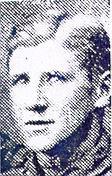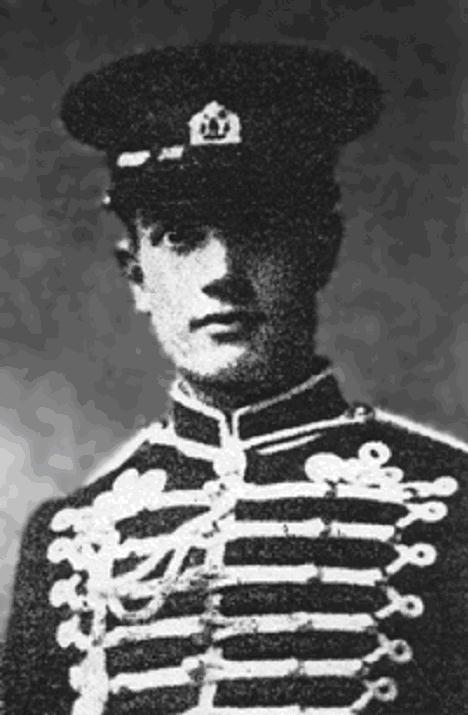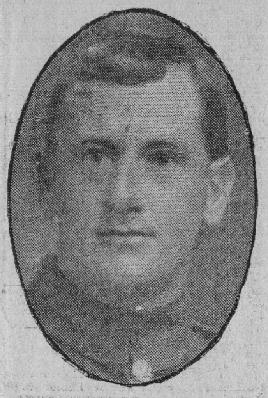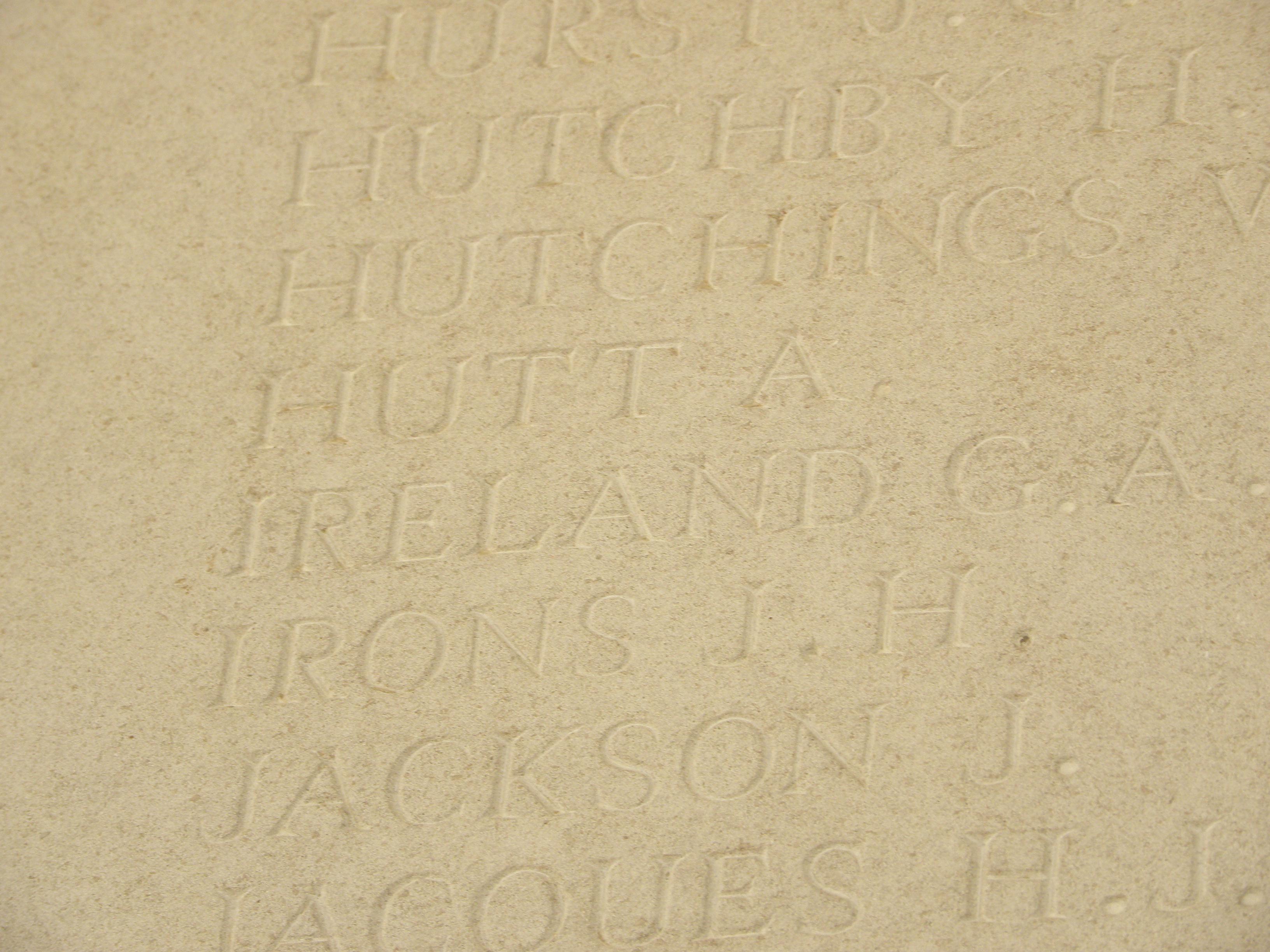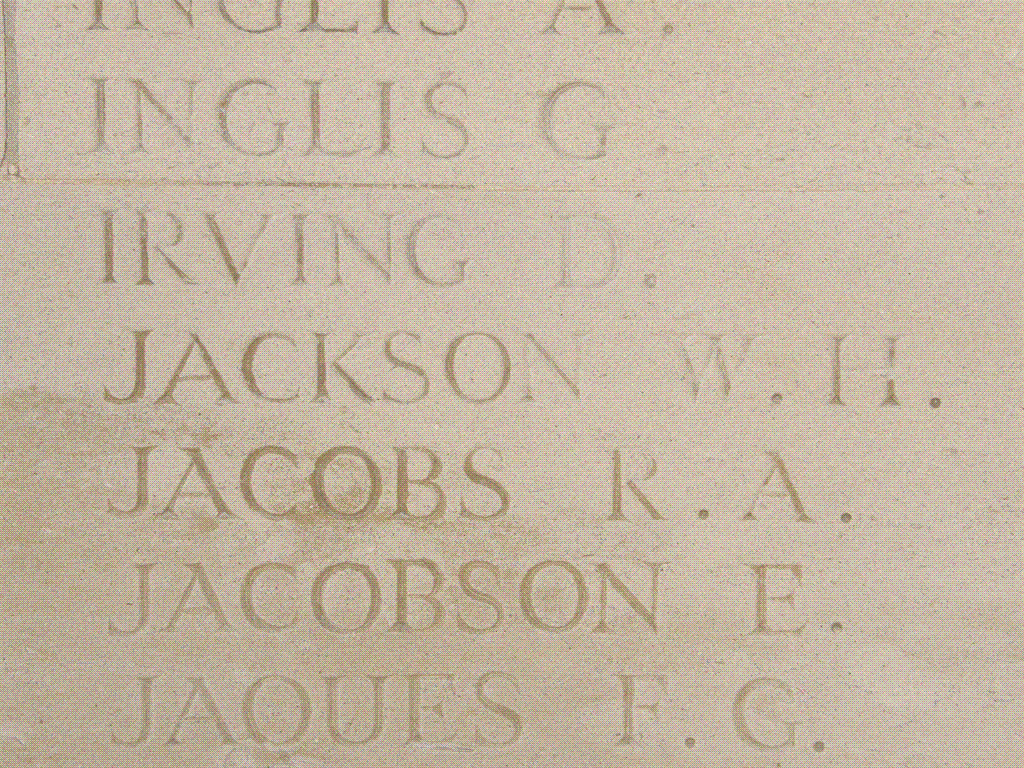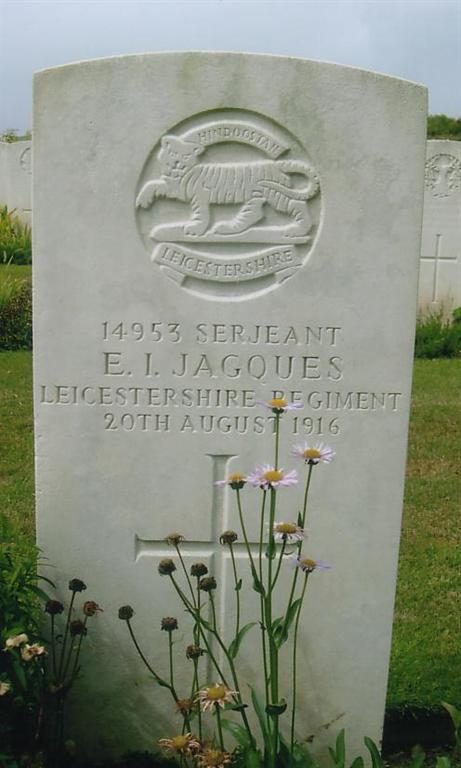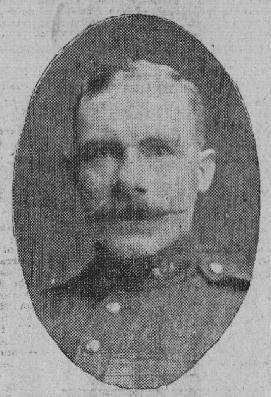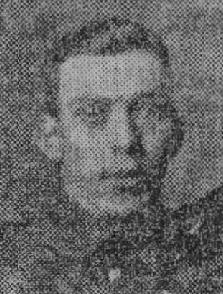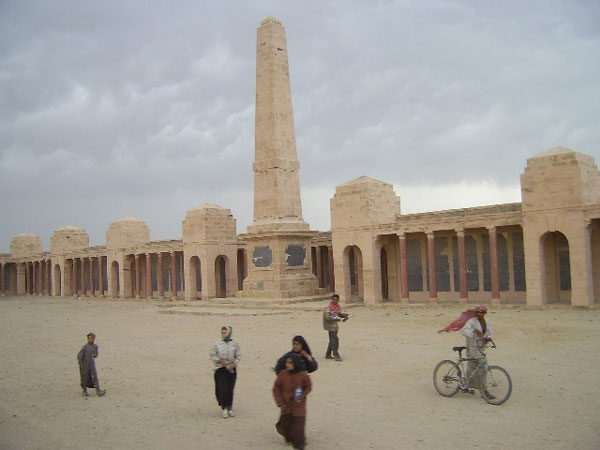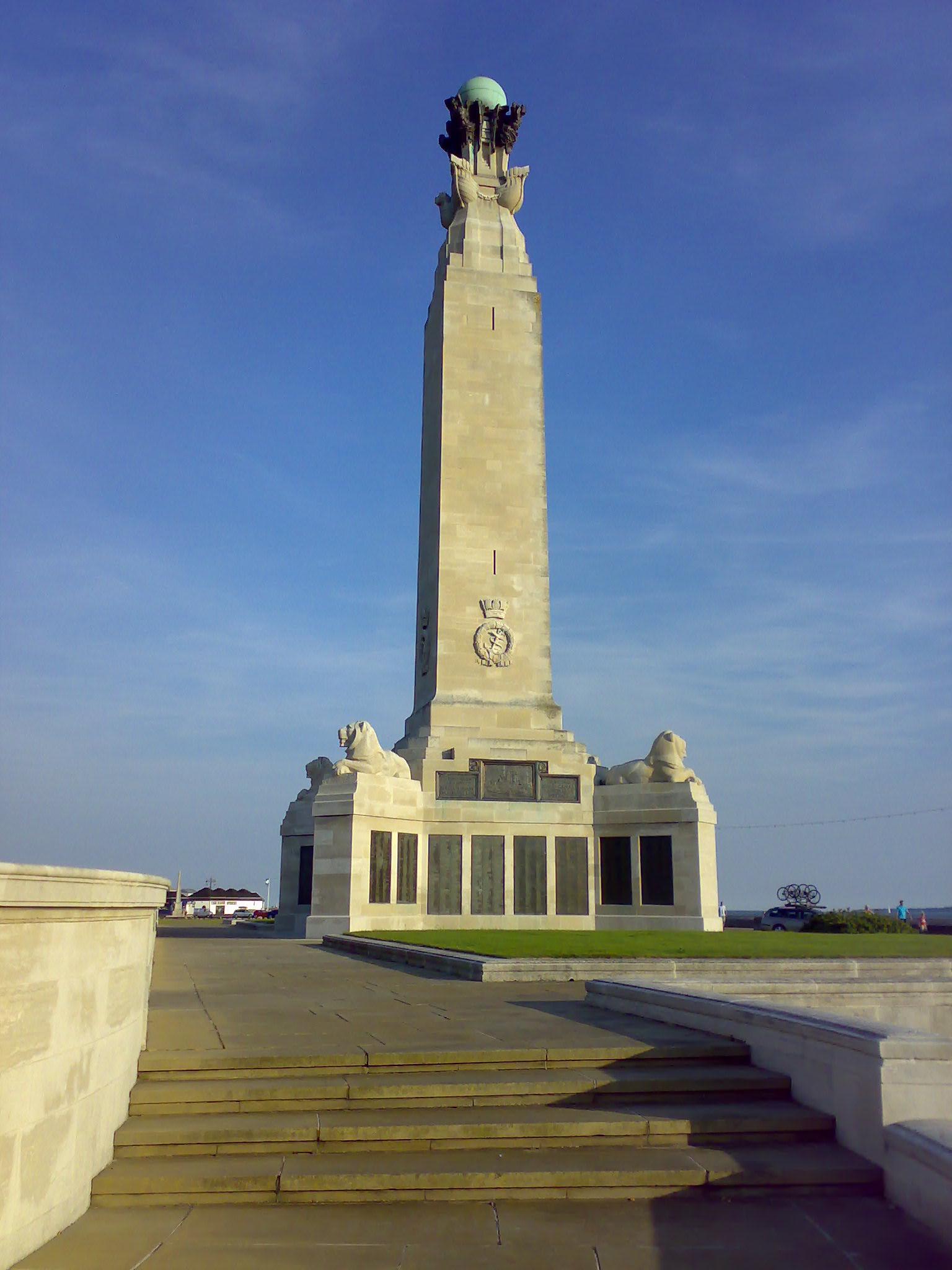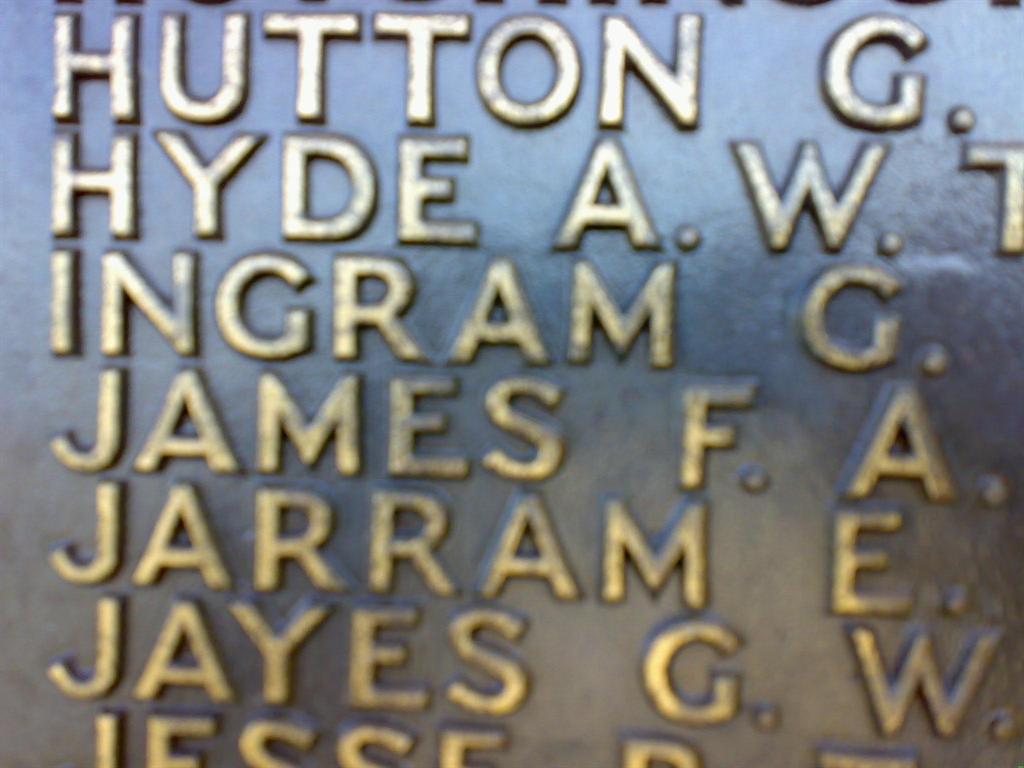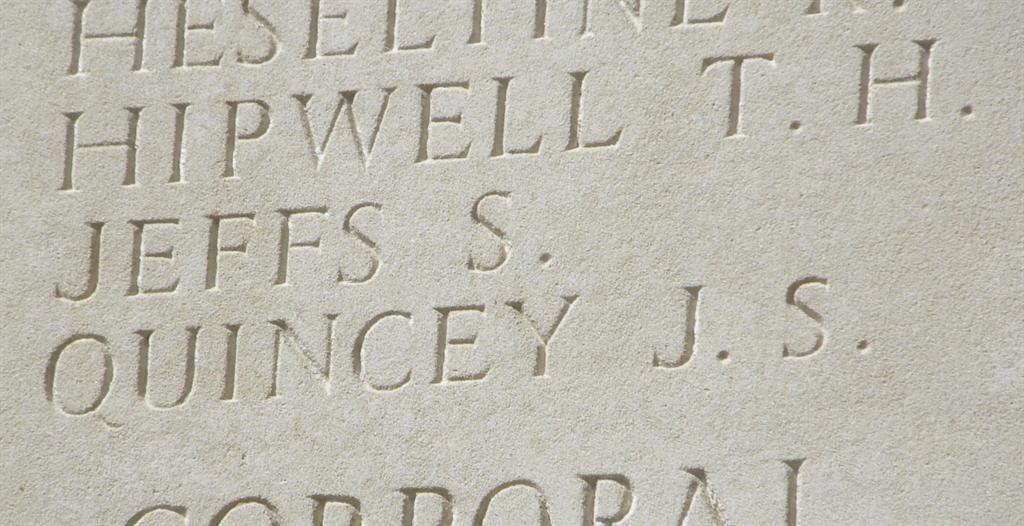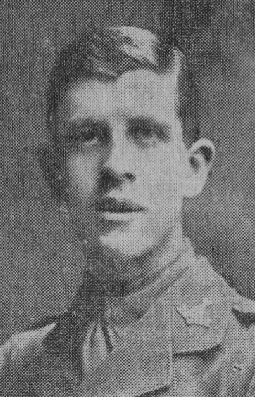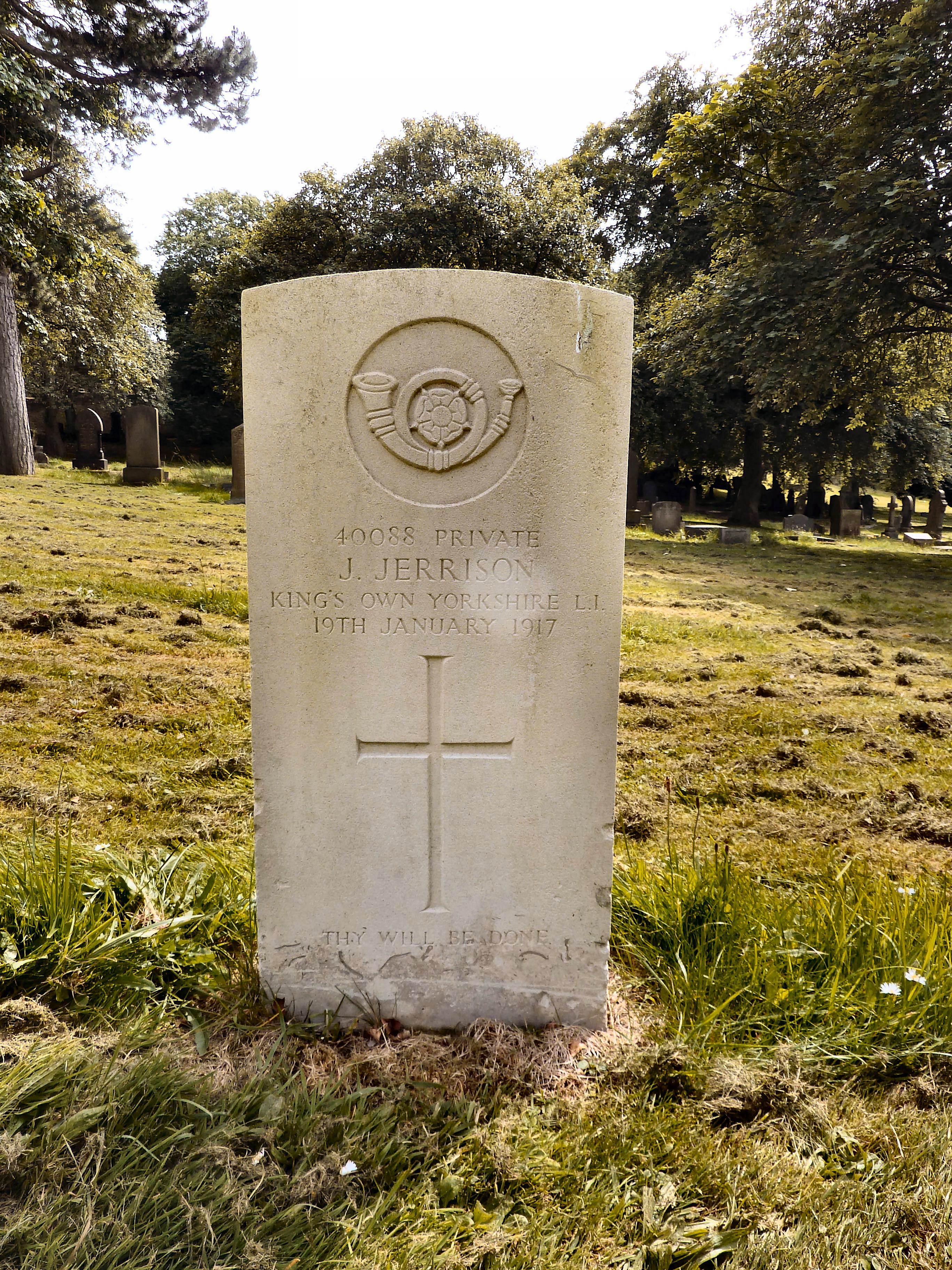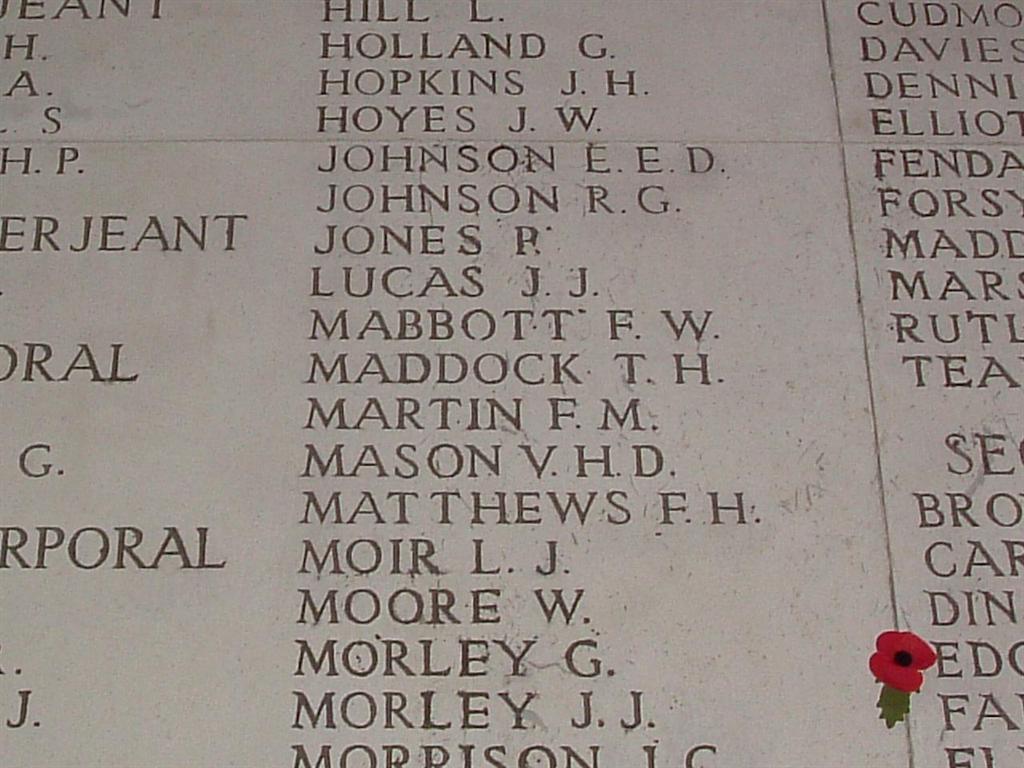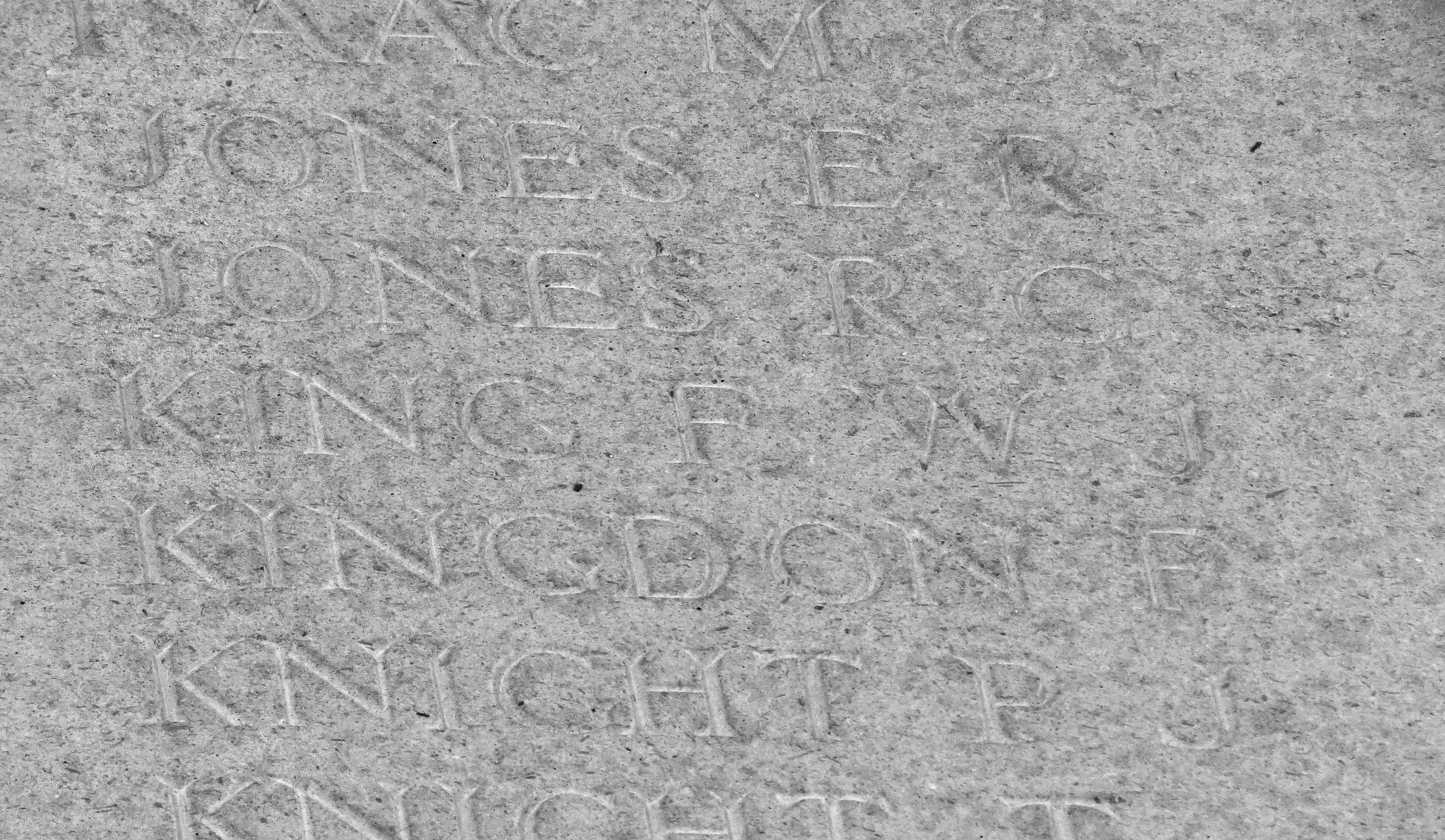|
Private 241703 George Alfred Ireland
|
|
1st Bn, Leicestershire Regiment.
Death presumed on or since 22nd March 1918, Aged 19.
Commemorated Arras Memorial bay 5.
(His brother Joseph Thomas Ireland also fell see below)
|
George Alfred Ireland was born in Shepshed in late 1898. He was the son of Joseph Ireland, a stone quarry labourer, and Emily Ann Ireland (née Sharpe) who were married at St. Botolph's Church, Shepshed, on Boxing Day, 1891. George had five brothers Cradock, Joseph, John, Maurice and Kenneth and four sisters Edith, Ethel, Constance and Emily. The Ireland family lived at Forest Street, Shepshed, but later moved to 67 Oxford Street, Loughborough.
George was a member of the Emmanuel Church Lads Brigade. Following his older brothers Cradock and Joseph he joined the Leicestershire Territorials in 1914 and was posted to the 1/5th Leicesters as Private 4643. When he enlisted, however, he was only 16 years old and on reaching France he was sent back home again.
During the First World War England had an estimated 250,000 boy soldiers fighting for the allies. This issue was corrected in time, but at one point the Army sent one in five soldiers home after a month because they were either too small to fight or underage. The situation had developed for a number of reasons. Boys were eager for adventure or scared of being called a coward. Underpaid recruitment officers turned a blind eye when the boys who came through were often from situations that seemed worse than war. Some parents made the mistake that war would be better than where they were and others believed that the war would end before the boys reached the front lines.
Undaunted after being sent home George later rejoined the Leicestershire Regiment as Private 214703 and on attaining his 19th birthday in late 1917 went to France for a second time, posted to the 1st Battalion of the Leicestershire Regiment.
In the early part of January 1918 the 1st Battalion was at Courcelles but on 18th went into the trenches on the Moeuvres front. Rest periods were taken at Luck and Lindop Camps near Fremicourt. On February 19th and 20th the battalion moved to the Lagnicourt area, where, when out of the line, they provided large working parties for work on the defences.
There were now strong rumours that the enemy was preparing a large offensive and great efforts were made to obtain information through patrols and raids. On 15th March the front line company of the battalion managed to capture a propaganda balloon laden with ten copies of the Gazette des Ardennes, a paper published in French by the Germans for distribution among the inhabitants of occupied territory.
On 21st March 1918 the enemy launched their Spring Offensive. George, aged 19, was presumed dead on or since 22nd March 1918. He is commemorated on the Arras memorial Bay 5. George is also remembered on memorials in Emmanuel Church and the former St. Peter's Church building, Loughborough, as well as on the Carillon.
George's brothers Cradock and Joseph also served with the Leicestershire Regiment during the war. Joseph was killed in 1915 on the first day of the Battle of Loos. Cradock survived the war.
|
|
|
|
Private 16409 Joseph Thomas Ireland
|
|
2nd Bn, Leicestershire Regiment.
Killed in Action 25th September 1915, Aged 20.
Commemorated Loos Memorial panel 42 - 44.
(His brother George Alfred Ireland also fell see above)
|
|
John Thomas Ireland was born in Shepshed in 1895, the son of Joseph Ireland, a stone quarry labourer, and Emily Ann Ireland (née Sharpe) who were married in Loughborough in 1891. Joseph Thomas was the third child in a family of ten; his siblings were: Edith, Cradock, Ethel, George, Constance, John, Maurice, Emily and Kenneth. The Ireland family lived at Forest Street, Shepshed and when young Joseph was 16 he was working as a stone quarry boy.
On 6th December 1912 Joseph, who was now a labourer for Loughborough Corporation and living at 67 Oxford Street, Loughborough, attested for the Territorial Army on 30th May 1913 and was posted as Private 1443 to the 5th Leicesters. He continued with the 5th Leicesters until 10th October 1914 when he was discharged. He re-enlisted in December 1914, joined the 2nd Leicesters as a Private and was sent to France on 4th May 1915. When Joseph arrived in France the 2nd Leicesters were preparing for a military operation in the Richebourg-l'Avoué area of the Pas de Calais. On 9th May they formed part of the second wave in the first attacks of the Battle of Aubers Ridge, without success. They saw action again on the night of 15th May, where the leading battalions met heavy resistance and Brigadier General Blackader was forced to call off the attack. After Aubers Ridge the corps was then rested in a quiet sector until September, when it was deployed for the Battle of Loos. Joseph was killed in action on 25th September, the first day of the Battle of Loos.
Joseph's brother George, who was with the 1st Leicesters, was killed in 1918.
|
|
|
|
Lance Corporal M2/194187 Reginald Roberts Irlam
|
|
2nd Mechanical Transport Coy. Royal Army service Corps.
Died of Pneumonia 30th November 1918, Aged 18.
Buried Terlincthun British Cemetery XII. A. 2.
|
Reginald Roberts Irlam (known to his family and friends as 'Bobs') was born on 18th February 1900 in Thayetmyo, Magway, Burma (now Myanmar). He was the son of Thomas Irlam and his wife Emma Louise (née Parfitt) who were married on 1st January 1899 at the Church of St. Michael the Archangel, Aldershot, Hampshire.
Bobs' father was a Sergeant with the South Staffordshire Regiment and his wife and family travelled with him. Bobs had two younger brothers; Thomas (known as 'Tom') born in 1903 in Dagshai, Solon, Himachal Pradesh, India, and Percival Roland (known as 'Roland) born in Lichfield, Staffordshire, in 1905. In 1911 Bobs was with his mother and two brothers at Whittington Barracks, Whittington, Lichfield, Staffordshire. When war broke out Bobs' mother moved to 29 Howard Street, Loughborough, with her sons while his father, who was now a Regimental Sergeant Major, was posted to the Kings Own Yorkshire Light Infantry for home duties.
Bobs enlisted in July 1916 and joined the Royal Army Service Corps. He did not reach the age of 18 years until 18th February 1918 and it is unlikely that he was sent abroad before that date. He was posted to the 2nd Mechanical Transport Company as Private M2/194187 and was soon promoted to Lance Corporal.
The British Army was already the most mechanised in the world in terms of use of mechanical transport when the Great War began. It maintained that leadership, and by 1918 this was a strategically important factor in being able to maintain supply as the armies made considerable advances over difficult ground.
All Mechanical Transport Companies were part of the Lines of Communication and were not under orders of a Division, although some (known as Divisional Supply Columns and Divisional Ammunition Parks) were in effect attached to a given Division and worked closely with it. Those in the Lines of Communication operated in wide variety of roles, such as being attached to the heavy artillery as Ammunition Columns or Parks, being Omnibus Companies, Motor Ambulance Convoys, or Bridging and Pontoon units.
The Divisional Supply Column Companies were responsible for the supply of goods, equipment and ammunition from the Divisional railhead to the Divisional Refilling Point and, if conditions allowed, to the dumps and stores of the forward units.
Bobs died of pneumonia on 30th November 1918, aged 18 in a hospital in the Boulogne area. He was probably a victim of the influenza epidemic.
He was buried in Terlincthun British Cemetery, Wimille, on the outskirts of Boulogne, Grave XII. A. 2.
|
|
|
|
Private 2079 William Harriman Jackson
|
|
2nd Bn, Highland Light Infantry.
Killed in Action 28th April 1917, Aged 22.
Commemorated Arras Memorial bay 8.
|
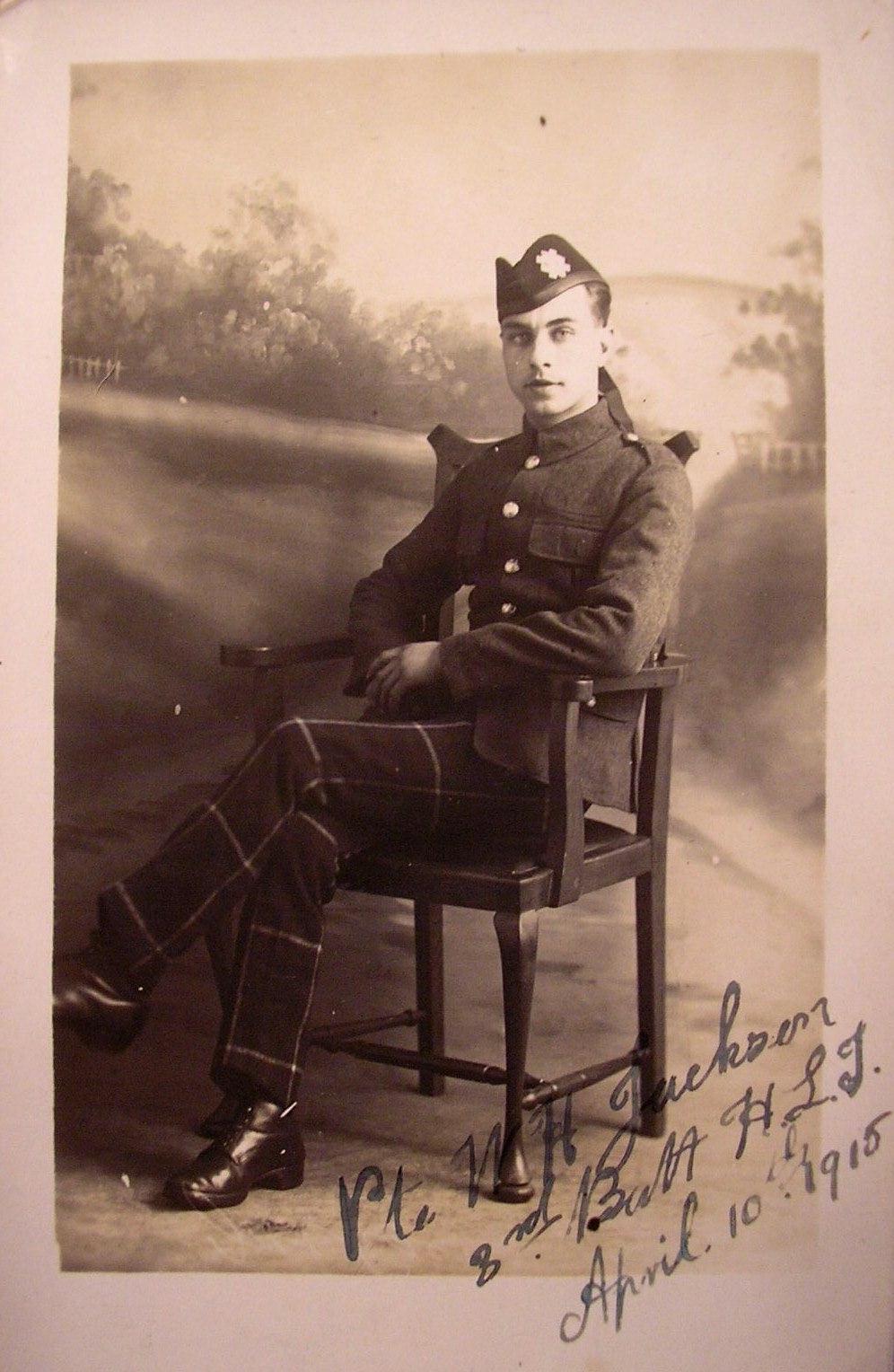 |
William Harriman Jackson, known as 'Willie' to his family, was born in 1894 in Loughborough, the son of John Jackson and his wife Fanny (née Randon) who were married at All Saints' Church, Loughborough, on 25th November 1893. Willie was baptised at All Saints' Church on 23rd July 1894. Willie's father was a needlemaker and in 1894 the family lived at 117 Paget Street. By 1901 they had moved to 41 Union Street and by 1911 to 68 Station Street. Willie had one sister Ivy; his only brother Samuel had died as an infant in 1898. In 1911 Willie was employed as a moulder in an iron foundry but later moved to Messrs. Messengers and Co., Ltd.
Willie enlisted in January 1915 and joined the Highland Light Infantry as Private 2079. He was sent to France to join the 2nd Battalion (known as the Boys' Brigade Battalion) on 26th May 1915. The 2nd Battalion was in the area of Vermelles, alternately in the trenches or training. At the end of June 1915 the battalion moved to the area of Givenchy where they carried out trench tours as well as tours at Beuvry and Cuinchy until the end of September.
The battalion was in action on the first day of the Battle of Loos, 25th September 1915. They captured some German trenches but heavy counter attacks drove the battalion back to its starting point. 329 casualties were sustained during the day.
From October to December the battalion was on trench tours in Vermelles, Cuinchy and Cambrin. January 1916 was mainly taken up with training at Bourecq and Bellerive and February with trench repairs at Festubert and Hingette. In March the battalion was in the front line at Fosse 10 (an old mining area on the outskirts of Sains-en-Gohelle). In April the battalion moved around between Coupigny, Thérouanne, Hersin and trenches in the Angres sector. In May they were cleaning craters at Bully-Grenay, in the trenches at Fosse 10 and providing working parties at Coupigny and Fresnicourt. In June there were trench tours near Souchez and at Berthonval.
At the opening of the Somme Offensive in July 1916 the battalion came under fire while working on trenches at Carency. After a break at Vaux-sur-Somme the battalion was in action at Delville Wood where they were heavily shelled. August and early September were spent on trench improvement before the battalion was back in the front line in the Redan sector until 11th November, with training breaks at Vauxchelles and Acheux. On 13th November, in the Battle of the Ancre the battalion attacked and took the enemy's front line trenches north of Beaumont-Hamel.
From December 1916 to 9th February 1917 training took place at Noyelles-en-Chaussée, Gézaincourt, Ovilliers, Aveluy and Bouzincourt. Returning to the trenches near Bouzincourt they were heavily shelled. On 21st March the battalion began a six-day march to Cauchy-à-la-Tour where further training took place until 9th April, after which the battalion moved to Bray-sur-Somme to dig a new front line.
An offensive operation in the area of Arleux as part of the 2nd Battle of Arras was being planned for 28th April 1917. On the first day of the Battle of Arleux Willie was killed in action, aged 22.
Willie is commemorated on the Arras Memorial, Bay 8. He is also remembered on the memorial in the former St. Peter's Church building, Loughborough, and on the Carillon.
|
|
|
|
Sergeant 14953 Eric Ivo Jacques
|
|
8th Bn. Leicestershire Regiment.
Died of Wounds 20th August 1916, Aged 24.
Buried Aubigny Communal Cemetery Extension I. E. 8.
|
Eric Ivo Jacques was born in 1891 in Barrow on Soar, the son of Robert William Jacques, a bricklayer, and Rose Jacques (née Kirby) who were married in Barrow on Soar in 1879. Eric was one of ten children. He had three brothers Robert William (Junior), Arthur, and Harold and four sisters Ann, Harriet, Mabel and Sarah. Two other siblings Frank and Mary had died young. In 1901 the family was living at 23 Gordon St, Loughborough, but by 1911 had moved to 53 Morley St. Prior to the war Eric worked as a moulder at Messenger and Co. and was a member of the Old Loughburians Football Club. For a number of years he was a drummer in the St. Peter's Church Lads Brigade, and latterly a teacher in the Woodgate Baptist Sunday School.
Eric came from an old soldiering family. He had a great-grandfather who was in the Royal Horse Guards (The Blues) who fought at Waterloo and had three horses shot under him and a grandmother who was born in Windsor Barracks. An uncle once walked from Barrow (where the family came from) to Chatham to enlist.
Eric enlisted on 4th September 1914 at Loughborough and joined the 8th (Service) Battalion of the Leicestershire Regiment on 24th September as Private 14953. He was promoted to Lance Corporal on 7th November 1914. From the Depot he was sent firstly to Aldershot for training and then to Shorncliffe in Kent at the end of February 1915. In April 1915 Eric's battalion became part of the newly established 37th Division of Kitchener's 2nd New Army and the Division began to concentrate on Salisbury Plain. On 25th June the units were inspected by King George V at Sidbury Hill. On 22nd July the Division began to cross the English Channel and Eric travelled from Folkestone to France on 29th July 1915. Initially the 37th Division concentrated near Tilques.
The 8th Battalion then moved via Watten, Houlie, St. Omer, Eecke and Dranoutre to Wulverghem and Berles-au-Bois. In the eleven months that followed the battalion was mainly based in the area of Bienvillers and Bailleulmont, a short distance from the front line south-west of Arras. They did tours in the trenches, the 6th Battalion alternating with the 8th Battalion who relieved them. The battalion was mainly Involved in localised operations in Bailleul, Le Bizet, Armentières, Mondicourt, Beauval and Berles-au-Bois. On 9th April 1916 Eric injured his ankle in bayonet fighting at the Brigade Sports Ground, while attacking trenches and scaffolds and was admitted to No. 6 General Hospital in Rouen three days later. He was discharged on 29th April and sent to convalesce at Etaples. He rejoined his battalion in the field on 20th May.
Eric was promoted to Corporal on 10th December 1915, to Lance Sergeant on 6th February 1916 and to Sergeant on 26th June 1916.
At the beginning of July the 8th Leicesters were sent to the Somme. On the 14th July the battalion was in action at the Battle of Bazentin Ridge. After the battle the battalion withdrew to Ribemont and then to Méricourt, and having entrained for Saleux, marched to Soues. From Soues the battalion moved to Longeau, Gouy-en-Ternois, Lattre St. Quentin and then to Arras where they went into the trenches on 29th July. Casualty figures for the battalion in July had been high: 17 officers and 415 other ranks had been killed, wounded or were missing.
The battalion went into Divisional Reserve at Agnez-les-Ouisans on 8th August but went back into the trenches on 18th August where they were on the receiving end of trench mortar bombs and heavy shells. Eric was wounded on the following day by a shell which exploded and damaged his jugular vein before he could take cover. He was taken to No. 30 Casualty Clearing Station and died on the following day, 20th August, aged 24. He was buried at Aubigny Communal Cemetery Extension, Somme, Grave I. E. 8.
Eric's brothers Robert William (Junior) and Harold and Eric's sister Mabel emigrated to the USA and settled in Philadelphia, Pennsylvania.
Eric is remembered on the war memorial in All Saints Church, Loughborough, on the Wood Gate Baptist Church Memorial and on the memorial in the former St. Peter's Church building, Loughborough, as well as on the Carillon.
|
|
|
|
Sergeant 241215 John Newton Jacques
|
|
2/5th Bn, Leicestershire Regiment.
Killed in Action 27th September 1917, Aged 25.
Commemorated Tyne Cot Memorial panel 50 - 51.
|
John Newton Jacques, known as 'Jack', was born in Barrow on Soar, Leicestershire, in 1892, the son of Martha Jacques. His father's identity was not disclosed but it is possible that his surname was Newton. Martha also had a daughter called Daisy Newton Jacques who may have been Jack's full sibling and a son called Wilfred Hoe Jacques who may have been Jack's half-sibling. In 1901 Martha Jacques was living at 2 Court B, Sparrow Hill, Loughborough, with her three children and a lodger William Hoe (who may have been Wilfred's father).
Wilfred Hoe Jacques died in 1907, aged 8, and in 1910 Daisy Newton Jacques married Frederick White and went to live in Leicester. In 1911 William Hoe, Martha and Jack were living at 70 Nottingham Road, Loughborough, and Jack was a labourer in an iron foundry. Jack's mother Martha died on 29th June 1913.
Jack enlisted at Loughborough and joined the 2/5th (Territorial) Battalion of the Leicestershire Regiment as Private 3349, later being renumbered as Private 241215. His precise date of enlistment is unknown as his service papers have not survived.
The 2/5th Battalion had its HQ in Loughborough as part of the Lincoln and Leicester Brigade, North Midland Division and was mobilised in September 1914. In January 1915 the battalion moved to Luton being billeted in private homes, in February and March they had a spell at Epping digging practice trenches. In July the battalion moved to the St Albans area, under canvas at Briton Camp for training and route marches. In August 1915, the Brigade was retitled 177th Brigade, 59th Division (2nd North Midland) and in October they were moved back to billets in Harpenden. Throughout 1915 some members of the 2/5th Leicesters also provided guards for the prisoner of war camp at Donington Hall.
In January 1916 parties of officers were sent to France on tours of instruction in the trenches and in March, the long awaited orders to proceed overseas were received. On Easter Monday, however, the rebellion in Ireland forced a rapid change of plans. The 177th Brigade was recalled from leave and ordered to move to Liverpool at midnight. The following day they sailed on the SS Ulster, a fast mailboat, escorted by a Royal Navy destroyer. Their first taste of action was not to be in the trenches of the Western Front, but in the streets of Dublin.
By the end of the month the main uprising was over and the 2/5th Battalion supplied search parties for Ballsbridge and guarded railways, bridges and other key infrastructure. On the 10th May they moved out of the city to tackle pockets of resistance in County Kerry, searching homes and making arrests. In June word was received that the Battalion would be moving to France and training resumed with long route marches through Ireland. In August they marched 80 miles from Tralee to Fermoy Barracks, where they would remain until January 1917, engaged in live fire training in trench warfare. The return trip from Ireland was made aboard the SS Ulster and the battalion arrived at Fovant Camp in Wiltshire by train at 7pm on 6th January 1917.
After embarkation leave they proceeded to France via Southampton, arriving at Le Havre on the 24th February 1917. They were sent to the Somme area where the enemy was retreating to the Hindenburg Line. They made their first attack on the villages of Hesbecourt and Hervilly on 31st of March 1917, capturing both villages and suffering a number of casualties.
On 1st April the battalion began constructing a line of cruciform posts and on the following day were shelled while doing so. On 3rd and 4th April part of the battalion supported the 4th Leicesters in an attack on Fervaque Farm while the rest of the battalion built posts in Templeux. On 11th and 12th April the battalion moved to Hervilly and Hamelet to provide working parties and on 15th A and C Coys were in support for an attack on Villeret. On 17th April the battalion moved from Brosse Woods to Templeux and Hervilly and were in support again on the following day in an attack on a quarry north of Villeret. On 19th April the battalion moved to Hancourt for cleaning up, working parties and training. On the night of 27th/28th April Hancourt was bombarded by the enemy and the battalion moved to the front line at Le Vergier.
Trench tours continued until 15th May when the battalion marched back to Bois Bias training camp between Bouvincourt-en-Vermandois and Le Catelet. Training took place until 25th May when they moved to Equancourt and went into the front and support lines at Villers Plouich. Here until 7th June more posts were constructed amid some heavy enemy bombardment. From 7th-16th June the battalion was in Brigade Reserve at Dessart Wood, after which the battalion returned to the front line at Villers Plouich and carried out cable digging and laying for the Royal Engineers. Attack training took place at Equancourt from 22nd-30th June, after which the battalion went into support at Metz-en-Couture until 10th July. For the rest of July and the first three weeks of August the battalion was in training at Barastre camp.
On 22nd August the battalion moved via Senlis to a front one mile south-west of Le Sars for further training. On 31st August they entrained at Albert for Hazebrouck and marched to a training camp north of Winnezeele where they remained until 20th September. By 23rd September the battalion was in the reserve trenches at St. Jean near Ypres, before taking over the front line at Hill 37, Hill 35 and Elmtree Corner. On 26th September the battalion went into attack to capture all enemy positions on Hill 37 (part of the Battle of Polygon Wood, a phase in the 3rd Battle of Ypres or Passchedaele). An enemy counter-attack was subsequently beaten back. On 27th September 1917 Jack was killed in action, aged 25, He had been promoted to the rank of Sergeant by the time he was killed.
Jack is commemorated on the Tyne Cot Memorial, Zonnebeke, panel 50 - 51, on the Carillon Memorial in Loughborough and on two war memorials in Quorn (the War Memorial at The Cross and the memorial at St. Bartholomew's Church) where members of his mother's family lived.
|
|
|
|
Private 760008 Albert Leonard James
|
|
102nd Bn. Canadian Infantry (Central Ontario Regt.)
Killed in Action 8th June 1917, Aged 37.
Buried Villers Station Cemetery IX. C. 20.
|
|
Albert Leonard James was born on 24th February 1880 in Tunbridge Wells, Kent, and baptised on 30th May 1880 in Tunbridge Wells. He was the son of Edward William James and his wife Jane (née Morley) who were married at All Saints' Church, Loughborough, on 24th January 1859. Albert had three brothers Charles, John and William and four sisters Helen, Jane, Sarah and Florence. In 1891 Albert's father was a machine agent and the James family lived at 13 The Avenue, Loughborough. After Albert's mother died in 1893 Albert's father became a cabinet maker and the James family moved to 47 Fearon Street. Albert was apprenticed as a piano maker to Mr. W. Castle, pianoforte dealer. Albert's father later moved to 79 Storer Road.
On 4th July 1906 Albert married Edith Green at All Saints' Parish Church, Loughborough and the couple emigrated shortly afterwards to Canada. They settled in Vancouver, British Columbia, and Albert found employment as a carpenter. By 1911 they had three children Walter, Ralf and Edith and were living at 1816 5th East, Vancouver. Albert was now employed as a labourer. By 1915 he had returned to carpentry and the family was living at 2142 Howard Street, South Vancouver.
Albert enlisted on 28th October 1915 in Vancouver. He joined the 121st Overseas Battalion of the Canadian Infantry (Central Ontario Regiment) as Private 760008. As part of the Canadian Expeditionary Force he embarked at Halifax, Nova Scotia, on 14th August 1916 and disembarked at Liverpool ten days later. He was then sent to Seaford, Sussex, for further training. On 10th January 1917 he was transferred to 16 Reserve Battalion at Seaford and on 16th February transferred again to the 102nd Battalion, before being sent to France four days later.
The operations of the 102nd Bn. from the beginning of 1917 to the capture of Vimy Ridge on April 9th was a story of preparation, progress and achievement. The Germans were firmly established on the crest of Vimy Ridge, from where they had complete observation of all the country lying to the south, whilst the British were entrenched on the southern slope leading down to Zouave Valley, every approach to which was in full view of the enemy.
When Albert joined his battalion on 21st February they were in huts at Hersin-Coupigny, about six miles west of Lens in the Pas de Calais. The battalion then did a series of trench tours until the end of March. The front line trenches were in bad shape; the retaliatory bombardment by the enemy had merged some trenches into one and a great deal of hard work was needed to put the area into a safe condition. On 11th March the battalion moved back to rest in Bouvigny Huts, a nine mile march away in a wood on a hill above Gouy Servins. The weather was bad, the mud intense and accommodation was crowded. There was no recreation other than one Y.M.C.A. hut. From 19th to 25th March the battalion was back digging a new front line trench after which some of the battalion moved to St. Lawrence Camp at Chateau de la Haie and others remained at Berthonval.
Early April was taken up with preparations and practice for an oncoming attack. Weather conditions were appalling and it was not until 9th April that the attack took place. Following an opening artillery barrage and in driving snow the 102nd battalion advanced and took three lines of enemy trenches despite constant enemy sniping. Combined operations caused the enemy to leave the Vimy Ridge and retreat towards the outskirts of Lens but the casualties were high.
On 11th April the battalion moved back to St. Lawrence Camp for one night before being ordered to march to Souchez. From there on 12th April they moved to billets in Cambligneul. From 21st April until 5th May the battalion was involved under the supervision of the Royal Engineers, in constructing roads for heavy artillery north of the Ridge and for this work was based firstly at a new camp, La Targette, and then at Comox Camp near Berthonval. On 10th May, after four days at Canada Camp, the battalion moved into support on the Vimy-Angres line and were heavily shelled. On 20th May they returned to Vancouver Camp, Chateau de la Haie until 28th May when the battalion moved up to Comox Camp.
The battalion was now set three tasks for the next trench tour: to capture a series of trenches known as 'The Triangle', to capture a strong-point consisting of a concrete machine-gun emplacement set in the railway embankment and formidably protected and to capture, consolidate and hold a new front line. All these tasks were eventually accomplished, but not without bitter and fierce fighting. Albert was killed in action on 8th June 1917, aged 37. He was buried in Villers Station Cemetery, Grave IX. C. 20.
Mr. James' niece wrote to Albert, and a few days later received the following reply from the Captain and paymaster: 'Dear Miss James, Your letter addressed to Pte. James has been passed to me for reply. I regret to inform you that your dear uncle was killed in action on June 8th on this front. He took part in a big engagement on this date and was killed instantly by a big shell. We buried his body in the Military Cemetery near here, and have erected a suitable cross to mark his last resting-place. He was a good brave soldier, and one that we could ill afford to lose, as his place is very difficult to fill. We shall miss him for all time to come, but trust that his noble example and his willing sacrifice will inspire us all to do our part the better. I desire to express to all his sorrowing friends our heartfelt sympathy, and we commend you all to the great love of our heavenly Father that He may administer such consolation that He alone can bestow'.
Albert is commemorated on the memorial in All Saints' Church and on the memorial in the former St. Peter's Church building, Loughborough, as well as on the Carillon.
Albert's widow moved from Vancouver and took a position as housekeeper to a farmer in Nicola, Canford, British Columbia. Her sons Walter and Ralf lived with her in Nicola. Her daughter Margaret had died, aged 4, on 30th March 1916.
|
|
|
|
Corporal William Henry James
|
|
2nd Bn. Leicestershire Regiment.
Killed in Action Mesopotamia 7th January 1916, Aged 26.
Commemorated Basra Memorial Iraq panel 12.
|
|
William Henry James was born in Loughborough in 1889, the son of Selina James. When he was ten years old his mother married William Albert Winton, an iron moulder, and went to live at 35 Cobden Street, Loughborough. Young William Henry, however, remained with his grandparents Martha and William James at 130 Station Road, Loughborough. He had three half-siblings Leonard, Evelyn and Albert Winton.
He enlisted at Leicester as a reservist with the 3rd Leicesters on 3rd November 1908. At the time he was a grocer's assistant and stated that he was a Wesleyan Methodist. He received training in musketry.
In 1911 William was still living with his grandparents at 17 Mills Yard, Woodgate, was employed as a fireman and was also a member of the Loughborough Branch of the Workers' Union. He married Harriet Francis on 30th July 1913 in Nuneaton, and the young couple settled at 14 Chapel Terrace, Southfield Road, Loughborough. William now had a job as a driller at the Empress Works.
William had received his discharge from the 3rd Leicesters on 5th July 1914 but when war broke out he was recalled. He reenlisted with the 3rd Leicesters on 3rd September 1914 as Private 13297 and was sent to Portsmouth. His wife last saw him in early October. On 12th December 1914 he embarked at Southampton for France, having been posted to join the 2nd Battalion of the Leicestershire Regiment who had arrived in France from India. In February 1915 he had a short stay in hospital with a foot problem but was back with his battalion in March fighting at the Battles of Neuve Chapelle (10th-13th March) and Aubers Ridge (9th May), the first day of the Battle of Festubert. On 19th May he was appointed an unpaid Lance Corporal.
The 2nd Leicesters spent the next couple of months alternately in the trenches or in billets while war training, in the area of Calonne and Vieille Chapelle north-east of Bethune. On 30th July William was admitted to No. 4 General Hospital, Versailles, where he remained until 21st August when he was discharged to Le Havre. On 26th September he rejoined his battalion which had just been decimated on the first day of the Battle of Loos.
In late October the 2nd Leicesters received orders to proceed to the Persian Gulf where Britain was fighting Turkish forces allied to the Germans. On 10th November 1915 William embarked at Marseilles and arrived at Basra on 8th December 1915. From there he travelled by boat up the River Tigris to Ali Gharbi, 150 miles south-east of Baghdad. He had been promoted to Corporal on 27th November.
In Mesopotamia General Townshend and his troops were under siege at Kut. On January 4th 1916 General Aylmer's leading troops, under Major General Younghusband, began to advance from Ali Gharbi towards Sheikh Sa'ad, with the intention of relieving General Townshend at Kut.
The Turkish commander Nur-Ur-Din had, however, effectively blocked any progress by placing approximately 22,500 troops and 72 guns on both banks of the Tigris at Sheikh Sa'ad, about 16 miles downstream from Kut. General Aylmer therefore ordered an attack on the enemy and very heavy fighting ensued on 7th January at the Battle of Sheikh Sa'ad, during which William was killed. He was aged 26.
William is remembered on the Basra Memorial, Iraq, Panel 12, and on the Emmanuel Church Memorial, Loughborough, as well as on the Carillon.
His widow was remarried to Albert Limmage in 1919 in Rugby, and went to live at Blue Ram Cottage, Dunchurch, near Rugby, Warwickshire.
|
|
|
Sergeant 31277 Bernard Jarram MM
|
|
19th Bn, Machine Gun Corps.
Previously 7th Bn, Prince of Wales's Volunteers (South Lancashire) Regiment.
Atd 19th Bn. Machine Gun Corps.
Killed in Action 18th April 1918, Aged 28.
Commemorated Tyne Cot Memorial, Zonnebeke, panel 92 - 93 & 162a.
|
Bernard Jarram was born in Loughborough in late 1889 or early 1890. He was one of eleven children of Francis Jarram, a framework knitter, and his wife Emma (née Harris) who were married in Loughborough in 1886. Bernard had six brothers Francis, Albert, Ernest, Edward (blind from birth), Leonard and Arthur and four sisters Kate, Alice, Nellie and Bertha. Between 1891 and 1901 the family lived at 38 Duke Street, Loughborough, but later moved to 23 Lower Cambridge Street.
In 1911 Bernard, aged 21, was working as a printer and compositor for Messrs. J. Corah and Son. On 3rd April 1915 he married Clara Ann Buswell at All Saints Church, Loughborough, and the young couple went to live at 139 Derby Road.
Bernard appears to have enlisted in the autumn of 1915, but the exact date of his enlistment is unknown as his service papers have not survived. He joined the 7th (Service) Battalion of the Prince of Wales's Volunteers (South Lancashire) Regiment as Private 31277. The date when Bernard was sent to join his battalion in France is also unknown but the 7th (Service) Battalion of the Prince of Wales's Volunteers received a draft of 70 Ordinary Ranks on 28th March 1916 and it is likely that Bernard was among this draft.
On 28th March 1916 the battalion was in Brigade Reserve working at Neuve-Chapelle, strengthening the line and erecting concrete machine gun emplacements. In early April the battalion completed two front line trench tours, where there was intermittent enemy shelling, with breaks at La Croix Barbet. On 16th April they began a three-day move via Robermetz and St. Floris to Linghem for training until 6th May. On 7th May the battalion entrained at Lillers for Longeau and marched to La Chaussée where training continued until 18th May.
On 19th and 20th May the battalion moved to a camp at Albert for a week's trench digging, returning to La Chaussée at the end of May. From 2nd-25th June there were practice attacks at Bois de la Croix de Pierre, Flesselles and Molliens-au-Bois, as well as route marches and sports. Toward the end of June the battalion marched to Baizieux Wood and then Henencourt Wood before going into the intermediate line trenches north-west of Albert.
On July 1st, the opening of the Somme Offensive, the battalion received an order to support the North Lancashire Regiment in an attack on Ovillers-la-Boiselle. Although this order was then countermanded, companies of the battalion did go into the attack on 3rd and 4th July and La Boiselle was finally captured after severe close-quarter fighting. After a break the battalion was back in the front line at Bazentin-le-Petit towards the end of July. The battalion then moved to Henencourt Wood and by lorry to Franvillers to rest.
In August the battalion moved in stages via Méricourt, Longpré, Pont Remy and Bailleul to shelters at Kemmel. Here the battalion received training before a trench tour. After the tour training continued at Wakefield Huts, Locre, before another trench tour took place.
During September the battalion was in huts and dugouts in Ploegsteert Wood, working for the Royal Engineers on communication trenches before moving to the front line to continue the work amid enemy raids and trench mortar attacks. The month ended in billets at Outersteene for company training.
On 5th October the battalion entrained at Bailleul for Doullens and marched to St. Léger-lès-Authie, arriving 'dead beat'. Two days later they began trench tours in the Hébuterne sector. Relieved on 11th the battalion marched to shelters at Coigneux and spent a week rehearsing an attack. Back in the front line from 22nd-24th October the battalion sustained 67 casualties. The end of October was spent in reserve trenches at Wood Post and Leipzig Redoubt in the Thiepval sector, improving the trenches and salvaging material.
From Aveluy at the start of November the battalion went into the trenches where conditions were appalling. A raid on enemy trenches on 12th November caused 62 casualties. On 18th and 19th November the battalion took part in a successful attack on Grandcourt, incurring 132 more casualties, after which the men were moved by lorry and bus to tents east of Warloy. November ended with a three-day march to Candas. The battalion remained at Candas until 8th January 1917 for inspections, training, brigade sports, and a variety show by the Royal Flying Corps.
On 9th January 1917 the battalion began a two-day march to Couin where training was continued, together with work on the nearby roads, until 20th January. January ended in the line at Hébuterne, working for the Royal Engineers and providing carrying parties but getting little sleep at nights because of enemy gas shelling. In February the battalion completed three more trench tours at Hébuterne with two breaks for training at Magnolia Camp, Sailly-au-Bois.
On 9th March, after further training at Authie, the battalion began a long march north via Longuevillette, Bouret-sur-Canche, Croix, Cauchy-à-la-Tour, Fléchin, St. Martin, Wallon Capell, Nordasques, Wizernes and Hazebrouck, arriving at De Zon Camp, north-east of Locre on 4th April. Two companies of the battalion were then sent to Haegadoorne to work on railway construction. On 8th April the battalion moved to Weston Camp, Scherpenberg, for training and to provide working parties for the Royal Engineers and ten days later to Murrumbidgee Camp near La Clytte. The rest of April was spent in the trenches at Ridge Wood.
May included training at a camp at Scottish Lines, Ouderdom, at Murrumbidgee Camp. and at Aintree Camp near Westoutre as well as several trench tours. At Carnarvon Camp from 2nd-5th June final preparations took place for a major offensive.
The Battle of Messines opened early on the morning of 7th June when eighteen British mines were exploded beneath the Messines Ridge and the attacking troops advanced up the slopes behind a creeping barrage. The 7th South Lancashires made a successful attack north of Wytschaete and took over the line, but were constantly shelled over the following days. Relieved on 15th June the battalion moved to Garden City Camp on Kemmel Hill, but the camp too was shelled. During the remainder of June the battalion was engaged in remaking the Kemmel-Wytschaete road.
During July there was training at Weston Camp, Butterfly Farm Camp and Irish House as well as trench tours at Onraet Farm, Onraet Wood and Oostaverne Wood. Further training ensued in August at Fromentel and at Escoevilles, near Boulogne, and the men were able to enjoy sea bathing. An officer wrote in the battalion's war diary rather wistfully: 'We thought we could see England'.
On 29th August the men were transferred by lorry and train to Bailleul and marched to Bell Farm Camp, St. Jans-Cappel. From here they provided working parties for burying cable in the forward areas. The battalion moved on to a camp on the Kemmel-Vierstraat road, then to Locrehof Farm, Locre for similar work. On 19th September the battalion was in support in dugouts on the south bank of the canal near Bois Carré and on the following evening went into the line. On 25th September the battalion moved into support in dugouts and tunnels at Hill 60 and at Buffs Bank and Casper's Cliff.
October was spent in the front line at St. Eloi, and in support at Hill 69, Bois Confluent. Larch Wood and Spoil Bank. Training breaks were taken at Bois Carré Camp and Clem Camp. The month ended with the battalion in the front line between Belgian Wood and Comines Canal. From Bois Carré on 5th November the battalion moved to Doncaster Huts, Locre, then to Stafford Camp, Westoutre, before marching to Bailleul, entraining for Ebblinghem and marching to billets at Morbecque. From 10th November - 6th December training took place, together with inspections and sport.
On 7th December the battalion marched to Steenbecque, entrained for Saulty and marched to Bailleulval, moving on to Courcelles-le-Conte and Etricourt on the following two days. From the reserve sector at Ribecourt they moved into the line for twelve days on 15th December. On 28th December the battalion supplied working parties at Havrincourt Wood before going into support at Highland Ridge on the Hindenburg Line on New Year's Eve.
In January 1918 the battalion completed further trench tours in the area of Marcoing with breaks at Hawes Camp, Havrincourt Wood and at Grazing Camp, near Léchelle, moving between Havrincout and Léchelle by light railway. During January the men were ordered not to drink water from shell holes as three men got gas poisoning this way.
Much of early February was spent draining and wiring the trenches under enemy trench mortar fire and in support in deep-mined dugouts in the Couillet valley.
At this point news came that the battalion was to be disbanded. The Prime Minister Lloyd George, afraid of further costly offensives, was deliberately holding back manpower in Britain and there was to be a wholesale reduction of British units on the Western Front to keep other units up to strength. The disbandment of the 7th Battalion of the South Lancashire Regiment began on 14th February and 80 Ordinary Ranks, including Bernard, were sent to join the 19th Division Machine Gun Corps Battalion which had just been formed.
Bernard's new battalion, billeted in a camp at the Le Transloy sugar factory, immediately went into training in barrage schemes, indirect fire and tactical exercises with tanks.
On 21st March, the first day of the German Spring Offensive, the battalion was ordered to take up positions east of Velu Wood, in Sunken Road, at Herries Switch, and at Millcross in support of a counter-attack on Doignes. On the following day D Company was ordered to positions north of Fremicourt where they fired 2,000 rounds. Six more guns were moved to the Cambrai road. Four guns never returned and were last seen surrounded by the enemy, firing at very close range. Two other guns were knocked out by shellfire. On 23rd March, after a massive advance by the enemy the battalion was withdrawn to Bapaume and then to the line east of Grevillers and to Frémicourt before moving to Souastre. For two days the guns were then in action at Hébuterne. Casualties from the battalion between 21st and 28th March numbered 326.
On 29th March the battalion entrained at Doullens for Kemmel and marched to Neuve Eglise for training and re-equipping and on 8th April was back in action in the Wytschaete-Messines sector. On 10th April the enemy commenced a heavy bombardment along the entire front which lasted until 19th April, resulting in 309 casualties in the battalion.
Bernard, now a Sergeant, was killed in action by a shell on 18th April 1918, aged 28. He was also awarded the Military Medal. The first news of his death came from a comrade who said that he had been buried in an English cemetery. The exact location of his grave, however, has been lost.
Bernard is remembered on the Tyne Cot Memorial, Zonnebeke, panels 92 - 93 & 162a. He is also commemorated on the memorial in All Saints Church, Loughborough, and on the Carillon.
His brother Albert served in the Royal Marine Light Infantry and survived the war.
|
|
|
|
Able Seaman 216322 Ernest Jarram
|
|
H.M.S. Good Hope Royal Navy.
Killed in Action 1st November 1914.
Commemorated Portsmouth Naval Memorial panel 2.
|
Ernest Jarram was born in Loughborough on the 10th March 1885. He was the son of John and his wife Eliza (née Oldham) who were married on 10th December 1864 at All Saints Church, Loughborough. Ernest's father was originally a boatman but by 1891 he had become a roadman and the family lived at 54 Sparrow Hill, Loughborough. Ernest had one brother John and one sister Lizzie. Five other siblings, Charles, Thomas, Edward, Sarah and Florence, died young.
Ernest's mother died in 1899 and his father in 1900. In 1901 Ernest, who was now an engineering apprentice, and his sister Lizzie were living with their brother John, his wife Kate and their daughter Florence at 95 Station Street, Loughborough.
Ernest was 16 when he joined the Royal Navy at Portsmouth on 10th August 1901. As Boy 216322 he underwent training on HMS Ganges, the Royal Navy shore base at Shotley, Suffolk, from 10th August 1901 to 3rd February 1903. His first posting was to a Minotaur-class frigate, HMS Agincourt and in March 1903 Ernest was promoted to Ordinary Seaman. Between 1903 and 1906 he served on HMS Duke of Wellington I, at HMS Excellent (a shore establishment at Whale Island, Portsmouth) and on the battleship HMS Centurion. In 1904, while on Centurion, he was promoted to Able Seaman. Between 1906 and 1912 he served at HMS Victory, HMS Victory 1, HMS Fisgard and HMS Excellent (all shore establishments). At sea he served on HMS Terrible (a Powerful-class protected cruiser), HMS Renown, HMS Vengeance and HMS Britannia (all pre-dreadnought battleships), HMS Seahorse (a survey ship), HMS Hampshire (a Devonshire class armoured cruiser) and HMS Monarch (a dreadnought battleship).
On 21st October 1911 Ernest married Rosetta Smith of 9 Rutland Street, Loughborough, at Emmanuel Church, Loughborough.
On 7th April 1914 Ernest moved to HMS Good Hope, an armoured cruiser. On the 1st November 1914, during the Battle of Coronel, German armoured cruisers, Scharnhorst and Gneisenau, sank HMS Good Hope, along with HMS Monmouth off the coast of Chile.
At around 19.30 on 1st November the German armoured cruisers under Admiral Graf Maximilian von Spee opened fire on the British fleet, which was silhouetted by the setting sun. The failing light made the German ships difficult to see and a direct hit on the Good Hope knocked out her forward 9.2 inch gun. The German gun crews maintained accurate and rapid fire and the leading British cruisers were hit more than thirty times. The reply from the British was largely ineffectual and as visibility deteriorated the Germans could target the fires on the British ships whilst all the British could aim for were the flashes of the German guns. At 19.50 HMS Good Hope endured a magazine explosion and very quickly sank. All of the 900 crew on board died, including Able Seaman Ernest Jarram, with a further 670 lost on the Monmouth.
Ernest's body was never recovered and he is commemorated on the Portsmouth Naval Memorial, Panel 2. He is also remembered on the memorial in Emmanuel Church, Loughborough.
|
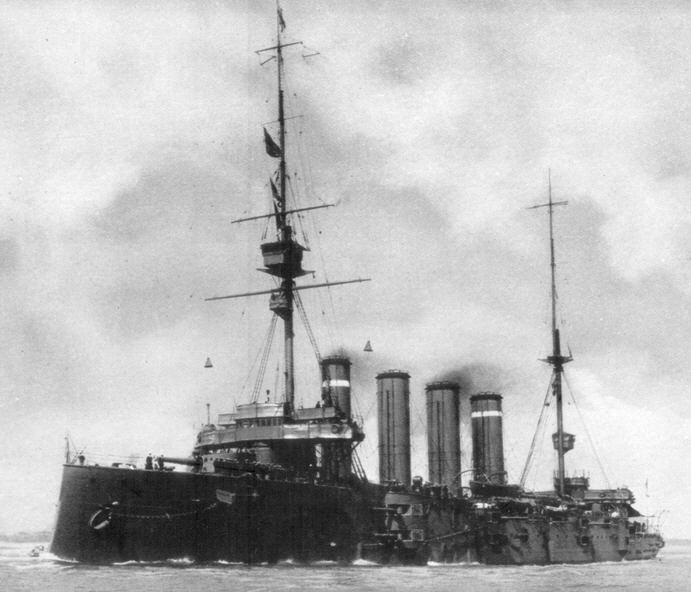 H.M.S. Good Hope
H.M.S. Good Hope |
|
Portsmouth Naval Memorial
|
|
|
Lance Sergeant 12722 Sydney Jeffs
|
|
8th Bn, Leicestershire Regiment.
Killed in Action 15th July 1916, Aged 25.
Commemorated Thiepval Memorial pier & face 2c & 3a.
|
Sydney Jeffs was born in Wellingborough, Northamptonshire, in 1891 and baptised with his brother Frank on 9th September 1896 at All Hallows Church, Wellingborough. Sydney was the son of Thomas Jeffs, a currier, and his wife Mary Ann (née Shortland) a grocer, who were married in Wellingborough in 1880. Sydney had two brothers Evelyn Ernest (known as Ernest) and Frank and one sister Dora. In 1896 the family lived at 42 West Terrace, in 1901 at 1 Bedale Road, in 1911 at 128 Midland Road, and in 1914 at 13 High Street, all in Wellingborough. By 1914, however, Sydney who had completed a three-year apprenticeship in the grocery trade, had left Wellingborough and was employed as a grocer's assistant in Loughborough.
Sydney enlisted at Loughborough on 3rd September 1914. He joined the 8th (Service) Battalion of the Leicestershire Regiment as Private 12722 and was sent to Aldershot. He moved to Shorncliffe Camp near Cheriton in Kent at the end of February 1915. In April 1915 Sydney's battalion became part of the newly established 37th Division of Kitchener's 2nd New Army and the Division began to concentrate on Salisbury Plain. On 25th June the units were inspected by King George V at Sidbury Hill. On 22nd July the Division began to cross the English Channel and Sydney travelled to France on 29th July 1915. Initially the 37th Division concentrated near Tilques and on 28th August Sydney was appointed a Lance Corporal (unpaid), a rank later confirmed with status changed to 'paid' on 4th December 1915.
From Tilques the 8th Battalion moved via Watten, Houlie, St. Omer, Eecke and Dranoutre to Wulverghem and Berles-au-Bois, a short distance from the front line. In the months that followed the 8th Battalion did tours in the trenches, alternating with the 6th Leicesters who relieved them. They were Involved in operations in Bailleul, Le Bizet, Armentières, Mondicourt, Beauval and Berles-au-Bois. In April 1916 the battalion moved to the Doullens area for six weeks for cleaning up, resting and training.
Between January and May 1916 Sydney was promoted twice, to Acting Corporal and then Lance Sergeant.
In mid-May the battalion returned once more to the trenches in the Bienvillers-Bailleulmont sector, but nearer Gommecourt. In June there was a series of nightly excursions into No-Man's Land with patrols attempting to gather information on the enemy's dispositions. On other occasions there were working parties out repairing the British barbed wire entanglements. The situation became increasingly hazardous as the month wore on when the Germans began to use a new and more accurate type of trench mortar.
The 8th Battalion did not participate in the first days of the Somme Offensive but was held in reserve. On 6th July they left billets at Humbercamps and marched to Talmas, continuing on the following day to billets in Soues. On 10th July the battalion marched to Ailly-sur-Somme, entrained for Méricourt and travelled from there by lorry to bivouacs in Méaulte. Between 10th and 13th July the battalion was in the trenches near Fricourt and subjected to fairly continuous enemy fire. On 14th and 15th July the battalion advanced on Bazentin Le Petit Wood. During this operation Sydney, aged 25, was killed in action on 15th July 1916.
A comrade, writing to Sydney's parents, said: 'I am sending these photos back which I found in the battlefield near some dead men of the Leicestershire Regiment. I also found the disc bearing your son's name where men of the Leicester Regiment had been buried. There had been a stiff fight for there were many dead Germans about'.
Sydney is commemorated on the Thiepval Memorial, Pier and Face 2C and 3A.
Sydney's brother Ernest who had emigrated to Australia served in France with the Australian forces as a Surgical Dresser in No. 3 Australian Casualty Clearing Station. He survived the war.
|
|
|
|
Second Lieutenant William Frederick Jelley MC
|
|
6th Bn. Yorkshire Regiment.
Died of Wounds 2nd November 1917, Aged 22
Buried St Sever Cemetery, Rouen, B. 4. 14.
|
|
William Frederick Jelley was born on 22nd August 1895 in Syston, Leicestershire and baptised on 10th October 1895 at the Church of St. Peter and St. Paul, Syston He was the only son of Police Sergeant Charles William Jelley and his wife, Temperance (née Timperley) who were married on 22nd December 1883 at All Saints Church, Loughborough. William had one older sister Mary. Charles and Temperance had two more children, but sadly they did not survive. In 1901 the family was living at 193 Main Street, Thurmaston but by 1909 had moved to Church Gate, Loughborough. In 1911 they were living at 36 Leopold Street.
William attended the Intermediate School in Loughborough and on the 28th September 1909, when he was fourteen, moved on to Loughborough Grammar School where he stayed for four years. His school report showed him to be a good scholar, except in French where he 'could do better'. He joined the Sixth Form in 1911 and although his French was still 'very poor' his results in mathematics were good. He left the Grammar School on the 30th July 1913 when he was almost eighteen to become a student teacher. He was also one of the founders of the Nanpantan Troop of Boy Scouts, of which he was Scoutmaster.
William was nineteen when war broke out and he had just completed his first year's teaching at the Church Gate Council School. He enlisted with the Leicestershire Regiment, and joined the 8th (Service) Battalion as Private 12151. From the Depot he was sent firstly to Aldershot for training and then to Shorncliffe, Kent, at the end of February 1915. In April 1915 William's battalion became part of the newly established 37th Division of Kitchener's 2nd New Army and the Division began to concentrate on Salisbury Plain. On 25th June the units were inspected by King George V at Sidbury Hill. On 22nd July the Division began to cross the English Channel and William travelled from Folkestone to Boulogne on the SS Golden Eagle on 29th July 1915. Initially the 37th Division concentrated near Tilques.
The 8th Battalion then moved via Watten, Houlie, St. Omer, Eecke and Dranoutre to Wulverghem and Berles-au-Bois, a short distance from the front line. In the months that followed the 8th Battalion did tours in the trenches, alternating with the 6th Leicesters who relieved them. They were involved in operations in Bailleul, Le Bizet, Armentières, Mondicourt, Beauval and Berles-au-Bois.
In April 1916 William had moved with the 8th Leicesters to the Doullens area for six weeks cleaning up, resting and training. In mid-May they returned once more to the trenches in the Bienvillers-Bailleulmont sector, but nearer Gommecourt. In June there was a series of nightly excursions into No-Man's Land with patrols attempting to gather information on the enemy's dispositions. On other occasions there were working parties out repairing the British barbed wire entanglements. The situation became increasingly hazardous as the month wore on when the Germans began to use a new and more accurate type of trench mortar.
The 8th Battalion did not participate in the first days of the Somme Offensive but was held in reserve. On 6th July William's battalion left billets at Humbercamps and marched to Talmas, continuing on the following day to billets in Soues. On 10th July the battalion marched to Ailly-sur-Somme, entrained for Méricourt and travelled from there by lorry to bivouacs in Méaulte. Between 10th and 13th July the battalion was in the trenches near Fricourt and subjected to fairly continuous enemy fire.
On the 14th July 1916 the battalion went into action at the Battle of Bazentin Ridge and during this engagement, on 15th July, William, who had been promoted through the ranks to Acting Sergeant, received a gunshot wound to his left arm. From a Base Hospital at Rouen he was returned to England on a hospital ship. Whilst he was recovering, William was put through a training course and on 25th January 1917 obtained a commission as Temporary 2nd Lieutenant with the Yorkshire Regiment (Alexandra Princess of Wales's Own) also known as the Green Howards. After seven weeks with the 3rd (Reserve) Battalion at West Hartlepool William was sent to France on 21st March to join the 6th Battalion at Mailly Wood Camp, north of Albert. From here the battalion was providing working parties on 268th Railway at Serre and Pusieux.
On 24th March the battalion moved to Vauchelles-les-Authie for training until 11th April, after which they moved back to Mailly-Maillet. After completing salvage work near Serre the battalion moved to Le Transloy on 20th April and provided working parties on second line defence. From Brigade Reserve on 29th April the battalion did a trench tour east of Hermies. After eight days in Divisional Reserve at Bancourt and Velu Wood and four days at Ovillers Huts east of Aveluy, on 18th May the battalion entrained for Bailleul and marched firstly to a camp north of Meteren and then to another camp north of Bailleul. From 6th-12th June they were in Corps Reserve near Kemmel and then near Lindenhoek. This was followed by a trench tour from 12th-19th June before a move began to a camp at Houtkerque, arriving on 23rd June.
Training took place at Houtkerque until 13th July and continued at Northleulingham until 24th July, after which the battalion moved via Arneke and St. Jan ter Biezen to a camp in a wood near the Elverdinghe road. On 8th August, while the enemy shelled the roads with gas shells, they moved up to dugouts at the Yser Canal. On 14th August the battalion went into attack at the Steenbeck, suffering 119 casualties. William was very badly wounded in the attack. When dark fell stretcher-bearers removed the young officer from the field. He was taken first to the field dressing station then on to a casualty clearing station. He was then transported to the No 2 British Red Cross Hospital in Rouen.
On the 22nd August his mother, Mrs. Temperance Jelley, received a telegram from the War Office, which read:
'(Urgent) You are permitted to visit 2nd Lt. W. F. Jelley, dangerously ill, gun shot wound head and thigh fracture femur, at No 2 Red Cross Hospital Rouen.'
William's parents travelled to Rouen to see their son. They found him in a critical condition; the gun-shot wound to his head was not life threatening, but the fracture to the femur was of great concern. It was during this time, whilst in hospital, that the news was conveyed on Second Lieutenant Jelley, that he had been awarded the Military Cross for Bravery in the Field on the 14th August.
One of the Royal Princes read his M.C. citation, which was reported in the London Gazette on the 8th January 1918, to him.
'T./2nd Lieutenant William Frederick Jelley, attd. York. Regiment. For conspicuous gallantry and devotion to duty in handling his platoon. Although wounded in the head he continued to lead his platoon until he had gained his objective. Later in the day, he was again wounded, having his thigh broken, but although in great pain and unable to move, he continued to urge on his men, and by his splendid pluck and fortitude kept up their spirits until after dark, when he was carried from the field.'
During the first week of September, having returned back home to Loughborough, William's mother received another telegram from the War Office, stating her son was still dangerously ill but that his condition was improved. The improved condition only lasted two weeks. William's father received another telegram on the 20th October 1917 saying that his son was again dangerously ill. He returned to his son's bedside at Rouen, his wife stayed at home. Mr. Jelley gradually saw his son's condition worsen, necessitating an emergency operation, on the 31st October, to have his leg and thigh amputated. William's condition never improved and he passed away, in his father's presence, on the 2nd November 1917, aged just 22 years.
His mother received a telegram from the War Office, which read: 'Deeply regret to inform you that 2nd Lt. W. F. Jelley, York. Reg., died of wounds, November second. The Army Council conveys their sympathy'.
William's funeral took place the following morning, at St. Sever Cemetery, Rouen. His father was present to witness his son being accorded full military honours. He was interred in Grave B. 4. 14. The epitaph on his headstone reads: 'I have fought the good fight, I have finished my course'.
William is remembered on the memorial in the former St. Peter's Church building, Loughborough, on Loughborough Grammar School's Roll of Honour, and on the Carillon.
|
|
|
Private 40088 Joseph Jerrison
|
|
14th Bn. King's Own Yorkshire Light Infantry.
Died 19th January 1917, Aged 38.
Buried Benfieldside Cemetery, Blackhill, Consett, County Durham..
|
Joseph Jerrison was born in 1878 West Bromwich, Staffordshire. He was the son of William Jerrison and his first wife Sarah Ann (née Parkes) who were married on 10th August 1873 at St. Thomas's Church, Dudley, Worcestershire. William Jerrison was an iron moulder, and after his first wife died, aged 32, in 1884, he was married again in 1891 to a widow Selina Fisher (née Garvey) in 1891.
Joseph had four full-siblings William, Maria, Sarah Ann and Reuben, one half-sibling Betsy (daughter of his father and Selina) and six step-siblings Hannah, Selina, William, Mary Ann, Charlotte and Nellie Fisher (Selina's children from her first marriage). In 1881 the Jerrison family lived at 40 Great Bridge Street, West Bromwich, but after Joseph's father married Selina they moved to 30 Henry Street to accommodate the expanded family. By 1901 most of the children had left home and Joseph's father and step-mother were living at 49 Phoenix Street with just Joseph and Betsy and one grandson Aaron. Joseph, aged 23, was now a labourer in an iron foundry.
On 9th October 1905 Joseph married Hannah Askey at St. John's Church, Newbold, Derbyshire, The couple moved to Chesterfield where they had a daughter Mary in 1907, but losing two other children in infancy. Joseph and Hannah then moved to 12 Shipstone Street, Ilkeston, Derbyshire, as Joseph had secured employment as a pipe moulder at Stanton Iron Works.
In late 1916 Joseph enlisted at Ilkeston and joined the 14th (Home Service) Battalion of the King's Own Yorkshire Light Infantry (K.O.Y.L.I.) as Private 40088. The 14th Battalion was part of the 72nd Division which had the dual role of carrying out training of men for overseas drafts, plus providing forces for home defence. The Division came under command of Southern Army, Home Forces, and was responsible for East Coast defences from the River Deben to Orfordness.
Joseph was not with K.O.Y.L.I. for very long, being discharged from the Army a few months after he joined. As his service record has not survived the reason for his discharge is unknown. Joseph did not, however, return home to his wife who was now living at 1 Court B, Pinfold Gate, Loughborough. but took a job at the Consett Iron Works, County Durham. A few weeks after he began work at Consett he tragically appears to have committed suicide.
The Middlesbrough Daily Gazette of 19th January 1917 carried the following report: 'About 7.30 this morning Joseph Jerrison who lodged with Private D. Cowey at 2 Trafalgar Street, Consett, was found lying in the kitchen of his lodgings with his throat cut and a razor by his side. He was a discharged soldier and had recently started work at the Consett Iron Works. PC Crosby rendered first aid and Dr. Macintyre was summoned but the man was dead'.
Joseph was only 38 when he died. He was buried at Benfieldside Cemetery, Durham Road, Blackhill, Consett, County Durham, Grave 6. C. 399. Although he had been discharged from the Army when he died he was accorded a military gravestone.
|
|
|
|
Private 6841 Ernest Francis Johnson
|
|
1st Bn. Coldstream Guards.
Died of Wounds 14th September 1914, Aged 26.
Buried Vendresse British Cemetery, Aisne, III. I. 9.
|
Ernest Francis Johnson was born in Loughborough in late 1887 or early 1888. He was the son of William Johnson, a needle maker, and his wife Agnes Mary (née Bishop) who were married in the Barrow on Soar registration area in 1882. In 1891 the Johnson family lived at 77 Wellington Street, Loughborough. Ernest had one older brother, Thomas Warrington Johnson, who became a bookbinder in Loughborough.
Ernest's father died in 1896 and his mother moved to 52 Leopold Street and supported her children by becoming a laundress. In 1901 Ernest, aged 13, was an errand boy. In 1909 Ernest's mother married Samuel Wood, a widowed colliery carpenter, and went to live at Sunnyside, Kilbourne [now Kilburn], Belper, Derbyshire. Ernest now had two step-sisters Alice and Lucy Wood.
Ernest enlisted with the Coldstream Guards sometime between 1901 and 1911 as Private 6841. The exact date of his enlistment is unknown as his service papers have not survived.
In the spring of 1914 Ernest married Winifred Millward at Belper. Winifred remained at Kilbourne and Ernest returned to his regiment. When war broke out he was stationed in Aldershot with the 1st Battalion and he went to France on 13th August 1914.
On 23rd August 1914 the 1st Coldstreamers, as part of the 1st Guards Brigade, took part in the Battle of Mons. After the battle the British Expeditionary Force went into retreat. On 26th August the 1st Coldstreamers had reached Fesmy and on the following day they marched to Etreux. Here they were deployed to defend the canal bridges before marching to Jonqueuse. Between 28th August and 5th September the battalion continued the retreat via St. Gobain, Pinon, Missy, La Ferté-Milon, Chambry, Jouarre, and Coulommiers to Nesles.
On 6th September the advance began and the battalion marched through Rozoy and took up a position at Voinsles. Here the formed the advanced guard to the 1st Division of the Army until they were ordered to retire to the crossroads at Rozoy. Later that day they advanced to Puiseau.
The march forward continued between 7th and 13th September via le Temple, Lucy-le-Bocage, Latilly, Bruyères and Bazoches to Moulins, north of the River Aisne. While on the march on 8th September the battalion intermittently came under long-range enemy artillery fire.
The Battle of the Aisne began on 13th September and the 1st Coldstreamers again acted as the advanced guard for the 1st Division. The battalion climbed with some difficulty up the narrow paths north of the river towards Vendresse and Cerny and were raked by enemy fire.
Ernest died of wounds, aged 26, on 14th September and was buried in Vendresse British Cemetery, Aisne, Grave III. I. 9.
Ernest's son, Francis Herbert Warrington Johnson, was born on 7th January 1915, four months after his father's death.
|
|
|
|
Private 203151 Joseph Edward Johnson
|
|
1/4th Bn. Leicestershire Regiment.
Killed in Action 21st December 1917, Aged 20.
Buried Cambrin Military Cemetery M. 29.
|
|
Joseph Edward Johnson was born in North Muskham, Nottinghamshire, in 1897 and baptised on 14th November 1897 at St. Wilfid's Church, North Muskham. He was the son of Henry Johnson (known as 'Harry') and his wife Hannah (née Dring) who were married on New Year's Day, 1883 at St. Wilfrid's Church. In 1901 Joseph's father was a grocer in North Muskham but by 1911 he had become the landlord of the Blue Greyhound Inn at Westborough, Nottinghamshire. Joseph had three brothers Thomas, Arthur and George and four sisters Eliza, Annie, Florence and Miriam. The family later moved to 3 Southfield Road, Loughborough, and Joseph was employed at the Nottingham Manufacturing Company.
Joseph enlisted in March 1915 and joined the 1/4th Battalion of the Leicestershire Regiment as Private 3902. He was later renumbered as Private 20057 and then as Private 203151. Joseph's service record has not survived but medal records indicate that he was not sent to France until 1916.
In the early spring of 1916 the 1/4th Leicesters were in the area of Talus de Zouaves, near Vimy Ridge. On 27th March the battalion relieved the 5th Lincolnshires in the front line trenches until 2nd April when the Lincolnshires relieved the Leicesters, a pattern which was repeated over the following weeks. The front line trenches were subject to heavy enemy bombardment.
On 23rd April the battalion moved to Mazières and then Savy for training until 9th May. Further moves followed to Le Souich and then Humbercamps for cable laying before a return to the trenches at Foncquevillers on 15th June.
On 30th June the battalion moved to billets in St. Amand-les-Eaux in preparation for the start of the Somme Offensive. On 2nd July the battalion transferred to Hannescamps and was heavily shelled. At Bienvillers-au-Bois on 15th July they launched a gas and smoke attack on the enemy. After a short period in training at Pommier and some work on trench improvement they moved into the trenches at Monchy-au-Bois on 1st August and were again shelled. Apart from a week in the trenches at La Cauchie the battalion remained in the Pommier/Bienvillers area until 28th October. November 1916 was spent training at Drucat, Domvast, and Mondicourt prior to a return to the trenches at Hannescamps in December
After a Christmas break at Souastre the battalion returned to the Hannescamps trenches, going into brigade Reserve at Bienvillers at the end of the year. Further trench tours followed at Hannescamps in January 1917, with breaks at Souastre. On 27th and 28th January the battalion pushed forward and advanced the front line in operations at Gommecourt.
In February 1917 the battalion took over a new front line facing Monchy-au-Bois and experienced a very heavy enemy bombardment of trench mortars and shells. March began with training at Souastre followed a return to the front line between Hannescamps and La Brayelle before a move over nine days to Flechin took place. April began with training at Flechin and Erny St. Julien followed by a move over several days to Lens, arriving on 18th April. Two trench tours north-west of Lens in the Cité St. Pierre sector took up the rest of April.
In May there was training at Noeux les Mines before trench tours in the Lievin sector on 12th and 18th May. Breaks at Red Mill and Fosse 10 included the digging of new trenches. June began with training for an attack which took place on the 8th June and was successful despite 74 casualties. From Brigade support in Lievin the battalion went into the line again west of Lens in the Cité Jeanne d'Arc sector on 10th and on 19th June with a break in between digging trenches. The battalion was in billets at Bouvigny Boyeffles from 22nd-27th June and took practiced at Marqueffles Farm for another attack.
From the trenches at the foot of Hill 65 on 28th June the battalion advanced in heavy rain and succeeded in their objectives. Another attack on 1st July was also successful. Relieved on 3rd July the battalion was taken by bus to billets at Monchy Breton and Orlancourt where training and sports took place until 27th July. From Brigade Reserve at Noeux les Mines the battalion was sent back to the trenches at Hulluch on 28th July.
Between 28th July and 28th November the battalion completed ten trench tours in the St. Elie sector with breaks at Fouquières, Philosophe and Mazingarbe. After this the battalion moved to Noeux les Mines for training until 1st December when they returned to the trenches, this time in the Cambrin sub-sector. Here on 12th December the battalion was on the receiving end of an enemy mustard gas attack. On 14th December the battalion moved to Beuvry into Divisional Reserve before returning to the line on 20th.
Joseph, aged 20, was killed by shellfire on 21st December 1917. He was buried in Cambrin Military Cemetery, Grave M. 29. He had previously been wounded and also gassed.
|
|
|
Sergeant 260012 Herbert Jones
|
|
2/5th Lincolnshire Regiment.
Formerly 2991 Leicestershire Regiment.
Killed in Action 26th September 1917, Aged 38.
Buried Bridge House Cemetery, Langemark-Poelkapelle B. 10.
(His step-son Percy Jones also fell see below)
|
Herbert Jones was born in Leicester in 1881, the son of Albert Alfred Jones and his wife Truelove (née Hartshorn) who were married in Leicester in 1868. He was baptised on 27th February 1881 at the Church of St. John the Divine, Leicester. Herbert's parents had sixteen children, nine of whom died young. Herbert's surviving brothers were Benjamin and William and his surviving sisters were Kate, Ellen, Florence and Evelyn. In 1881 the Jones family was living at 1 Court A, Stamford Street, Leicester but by 1891 had moved to 26 Woodbine Avenue, Highfield Street, Leicester. The family later moved to 8 Woodbine Avenue. Herbert's father was a clicker in the shoe trade and his mother was a shoe machinist.
On 19th January 1898 Herbert, who was a shop assistant for Mr. Jackson in Gallowtree Gate, Leicester, attested to join the Leicestershire militia. He joined the 3rd Battalion of the Leicestershire Regiment as Private 6532 and completed 49 days of drill. On 4th March 1898 he was transferred to the Northamptonshire Regiment as Private 5424. On 7th July 1898 he was posted to the 2nd Battalion; on 11th May 1899 was appointed a Lance Corporal (unpaid) and on 18th August 1899 a Lance Corporal (paid). Herbert's promotion was revoked for misconduct, however, on 15th October 1899 and he was sent to the Regiment's depot.
On 27th January 1900 Herbert was sent to join the 2nd Battalion which was fighting in the 2nd Boer War in the Orange Free State, South Africa. He took part in the Battle of Paardeberg from 8th-27th February 1900. In October, November, and December 1900 the battalion was part of a column under Major General Douglas which operated in the south-west of the Transvaal. Early in 1901 the battalion was taken to the Central Transvaal, and along with the Wiltshire Regiment occupied posts on the line between Warm Baths and Pietersburg. The battalion was employed chiefly in this district till the close of the campaign. Herbert was awarded the Queen's South African medal with clasps for Cape Colony, Orange Free State, and the Transvaal.
On 19th July 1902 Herbert was back in England at the Depot and on 5th June 1903 was transferred to the Army Reserve. He was subsequently employed from 1906 to 1910 as a Court Bailiff in Leicester. In 1908 he married a widow Annie Elizabeth Allen (née Spencer) in Leicester and he and Annie set up home at 76 Gladstone Street, Loughborough, with Annie's son Percy Spencer Allen. Between 1910 and 1914 Herbert held the stewardship of the Loughborough Club and was well known and highly respected in Loughborough.
At the outbreak of war he immediately answered the call to the colours and enlisted in the Leicestershire Regiment in September 1914. After acting as Mess-Sergeant 2991 to the 5th Leicesters, he was transferred to the 2/5th Lincolnshire Regiment as Sergeant 260012. Herbert's First World War service record has not survived and his date of transfer is unknown. It is also not known if he went to Ireland in 1916 to take part in actions against the rebellion there until January 1917. Herbert may have gone to France with the 2/5th Lincolns on 23rd February 1917. Alternatively he may have been among the batch of reinforcements which joined the battalion on 1st June 1917 or in one of a number of batches joining throughout August 1917.
On 23rd February 1917 the main body of the battalion entrained at Dinton, Wiltshire, for Southampton where they embarked on the SS Connaught for Le Havre. Having arrived in France they entrained for Le Saleux and marched to Baconval. From Baconval they marched to Bayonvillers and from 1st to 6th March were in training there. The battalion was then sent to repair the front line and communication trenches where conditions were so bad that it was necessary to dig men out of the mud. Further trench tours followed at Villers Carbonnel, Estrées-Mons, Beaumetz and Nobescourt Farm.
In early April the battalion moved to Templeux and Hargicourt and came under enemy fire. Ordered to attack on 11th April they took part in a heavy engagement and 250 Ordinary Ranks were killed, wounded or missing. Between 19th and 23rd April the battalion was in Vraignes repairing the roads, or in training before being sent to work on the resistance line at Le Verguier. Further road work ensued at Jeancourt before the battalion moved to Cartigny and then Equancourt for training. At the beginning of June the battalion provided more working parties for strengthening the trench lines at Beaucamp and then at Neuville in early July. From 11th July until the end of August the battalion was in training at Barastre and Hedauville.
On 31st August the battalion entrained at Albert for Proven and marched to Winnezeele via Briele. They remained in camp at Winnezeele and then at Hilhoek until 23rd September practising attack formations. On the night of 23rd/24th September the battalion moved up from the assembly camp at Goldfish Chateau, just outside Ypres, to trenches south of Wieltje. On 26th September the Battle of Polygon Wood (a phase of the 3rd Battle of Ypres, or Passchendaele) began.
Herbert was killed in action at this battle, aged 38. He was one of an estimated 350 Ordinary Rank casualties from the battalion. He was buried in Bridge House Cemetery, Langemark-Poelkapelle, Grave B. 10. The Captain of Herbert's company wrote to Mrs. Jones that her husband was hit by a shell and was, he believed, killed instantly, so that he could have suffered no pain. He added: 'I need hardly say we shall miss him particularly in this company. The whole company join with me in offering you our sincere sympathy in your sad bereavement'.
Herbert's step-son Percy Spencer Jones, a trooper with the Leicestershire Yeomanry, was killed in action in the Battle of Frezenburg in May 1915.
|
|
|
|
Private 1920 Percy Spencer Jones
|
|
1/1st Leicestershire Yeomanry.
Killed in Action 13th May 1915, Aged 20.
Commemorated Ypres Menin Gate panel 5.
(His step-father Herbert Jones also fell see above)
|
|
Percy Spencer Jones was born Percy Spencer Allen in 1894 and was baptised on 9th December 1894 at Holy Trinity, Bordesley, Warwickshire. His father Thomas Allen, a viewer of guns, had married his mother Annie Elizabeth Spencer on 21st July 1891 at Christchurch, Sparkbrook, Warwickshire and Percy was the only child from this marriage. By 1901 the Allen family were living at 88 Bawtry Road, Attercliffe cum Darnall, Yorkshire.
Thomas Allen died sometime between 1901 and 1908, and in 1908 Percy's mother Annie was married at Leicester to Herbert Jones, a county court bailiff eight years younger than herself. Herbert and Annie Jones set up home at 76 Gladstone Street, Loughborough. In 1911 Percy was a porter for a fishmonger and late in 1912 or early 1913 he joined the Leicestershire Yeomanry as Private 1920, adopting his step-father's surname of Jones on enlistment.
The Leicestershire Yeomanry was headquartered in Leicester and C Squadron was based in Loughborough.
The 1/1st Leicestershire Yeomanry was mobilised on 5th August 1914 and billeted in the village of Palgrave, Suffolk, until 1st November 1914. On 2nd November they entrained at Diss with the horses and travelled to Southampton Docks. They sailed for France, arriving at Le Havre the following day, and proceeded to No. 2 Rest Camp. On 4th November they entrained for St. Omer and marched to Esquerdes where they remained for four days to carry out bayonet and entrenching exercises.
On 11th November they marched to Eecke to join the 3rd Cavalry Division and on the following day proceeded via Poperinghe to Bellewaarde Farm on the Hooge Road east of Ypres. Here they joined the 7th Cavalry Brigade and were sent to the support and reserve trenches. On 16th they moved to billets in Ypres where they were heavily shelled. From 17th - 21st November A and C Squadrons were in the advance, support and reserve trenches east of Zillebeeke and B Squadron was in dugouts near the Menin-Ypres road. From 22nd November to 4th December they were at St. Sylvestre near Caestre refitting and exercising while being on duty in General reserve.
On 3rd December they paraded with the 7th Cavalry Brigade for an inspection by His Majesty the King. From 7th -17th December they were based at Oxlaere and then Berthen for drill and entrenching practice while again being in General reserve. On 18th December they moved to an area south of Hondeghem and the Caestre road. Here classes for reserve stretcher bearers and machine gunners took place. On 22nd December they moved to La Brearde where they remained until 2nd February 1915 for training in an advanced guard scheme, hand grenade and entrenching instruction, route marches and inspections.
On 3rd February they were transported by bus to Ypres and marched to Zillebeke where they took over the front line trenches. They spent several days draining and improving the trenches amid enemy sniping. Relieved on 8th February they moved to billets in Ypres as part of the General reserve. On 11th February there was heavy shelling near their billets and on the following day they moved by bus back to La Brearde. Training took place there until 11th April.
On 12th April they moved to Renescure and on 23rd April marched via Abeele to Godewaersvelde. On 24th they proceeded to Vlamertinghe before moving at night to Reninghelst. On 25th and 26th April they moved via Poperinghe and Watou to Forge, where they left the horses, and returned to Vlamertinghe. On 27th they were shelled out of their huts and bivouacked in a field. On 28th they moved to Abeele and over the next three days met up with the Brigade at Forge.
In early May they left the horses at Vlamertinghe and marched to Hazebrouck before going by bus to Brielen near Ypres. On 12th May, as dismounted infantry, they took over the trenches north of the railway near Bellewaarde Farm and immediately became involved in the Battle of Frezenberg Ridge (otherwise called the 2nd Battle of Ypres). During this battle on 12th and 13th May the Leicestershire Yeomanry suffered 186 casualties.
Percy was killed in action at the Battle of Frezenberg. He is commemorated on the Ypres (Menin Gate) Memorial, Panel 5.
Percy's step-father Herbert Jones, a Sergeant with the 2/5th Lincolnshire Regiment, was also killed in action in 1917.
|
|
|
|
Private 30106 Randolph Cecil Jones
|
|
9th Bn. Devonshire Regiment.
Formerly Private 25632 Leicestershire Regiment
Killed in Action 25th March 1917, Aged 31.
Commemorated Arras Memorial bay 4.
|
|
Randolph Cecil Jones was born in 1885 in Nottingham, the son of Samuel Matthew Jones and Frances Porter (or Potter) Jones (née Shaw) who were married in Nottingham in 1881. Randolph had two sisters Mabel and Alice and a brother William. Randolph's father was initially a groom to a physician and surgeon in Nottingham, but by 1891 he had become a cab proprietor in Loughborough and the Jones family was living at 6 Sparrow Hill. In 1901 they were living at 12 Mill Street, Loughborough and in 1911 at the Barley Mow Inn where Randolph's father was now the licensed victualler.
When Randolph was 15 he was learning to be a joiner and in 1911 he was working as a coach maker for the Brush Company. After 1911 he worked at the Black Lion Inn and subsequently moved to the Albion Inn until he enlisted in February 1916.
Randolph joined the Leicestershire Regiment as Private 25632. Information about his military service is scarce as his service record has not survived but at some point in 1916 he was transferred to the 9th (Service) Battalion of the Devonshire Regiment.
The 9th Devonshires had been in France since August 1915 as part of the 30th Brigade, 7th Division of the Army. After the Battle of Loos where the battalion suffered 476 casualties, they moved to Givenchy and then in 1916 to the Somme. On 1st July 1916 the battalion led the attack towards Mansel Copse, where well-placed machine guns, whose crews had survived the preliminary bombardment, cut down hundreds of advancing men. On 13th/14th July the battalion was involved in a night attack on Bazentin. By the end of July the battalion had lost many men on the Somme and was withdrawn for rest and reconstruction. In early September the 9th lost heavily again from shelling during an attack near Ginchy. When Randolph joined the 9th Battalion in 1916 is unknown but it could have been at any point during the summer or autumn.
From mid-November 1916 the battalion took part in the Operations on the Ancre. The initial Allied move was to advance the trenches to within assaulting distance of the Le Transloy- Loupart line before the weather deteriorated. In January 1917 as soon as active operations again became possible, proceedings were commenced to drive the enemy from the remainder of the Beaumont-Hamel Spur. This was followed by a push across the Beaucourt Valley to the western slopes of the spur beyond from opposite Grandcourt to Serre.
The next objective was to carry the line forward along the spur which ran northwards from the main Morval-Thiepval Ridge about Courcelette, and so gain possession of the high ground at its northern extremity. Despite many counter-attacks by the enemy and some fierce fighting the enemy began to evacuate the area and by 25th February the enemy had mostly been successfully driven back to the Le Transloy-Loupart Line.
The enemy's final position at Irles was successfully taken on 10th March. After a heavy artillery bombardment on 12th-13th March the enemy fell back further. It became clear that the enemy had begun to withdraw to the Hindenburg Line, a defensive system which ran south-eastwards from Arras for twelve miles to Queant and passed west of Cambrai towards St. Quentin.
Further allied advances were made and by 18th March Chaulnes and Bapaume had been captured, and advanced bodies of Allied troops had pushed deeply into the enemy's positions at all points from Damery to Monchy-au-Bois. On subsequent days the advance continued but as the Allies came within two to three miles of the Hindenburg Line enemy resistance increased and minor engagements multiplied from day to day along the front. During one of these engagements on 25th March 1917 Randolph was killed in action, aged 31. In a letter to Randolph's parents his platoon officer said: 'Your son died nobly for his country carrying out his duty on one of the advanced posts. We much deplore the loss of a brave comrade. I laid him to rest in a quiet spot, and erected a little cross'.
Randolph is commemorated on the Arras Memorial Bay 4.
Randolph's elder brother William who served with the Leicestershire Regiment in Egypt and East Africa survived the war.
|
|
|
|
